
Welcome to the Deeto Hub
A resource and community space for modern marketers, sellers, and builders using customer voice to grow — together.

A resource and community space for modern marketers, sellers, and builders using customer voice to grow — together.
This hub is built for anyone who wants to do more with the voices of their customers. Whether you're scaling advocacy, building trust with proof, or rethinking how to go to market — you're in the right place.
How-to guides and playbooks for building with customer voice
Campaign-ready templates and swipe files
Benchmark reports and reference best practices
Event recordings, expert sessions, and community spotlights
Ask questions. Share ideas. Trade wins. This is your space.
You don’t have to figure this out alone. The Deeto community connects you with other leaders using customer voice to build better GTM motions, faster-growing brands, and smarter strategies. If you are interested in joining when it launches, sign up below.
Automate advocacy management workflows
Dynamically generate customer stories and social proof
Eliminate manual reference management
Track and report advocacy impact on revenue
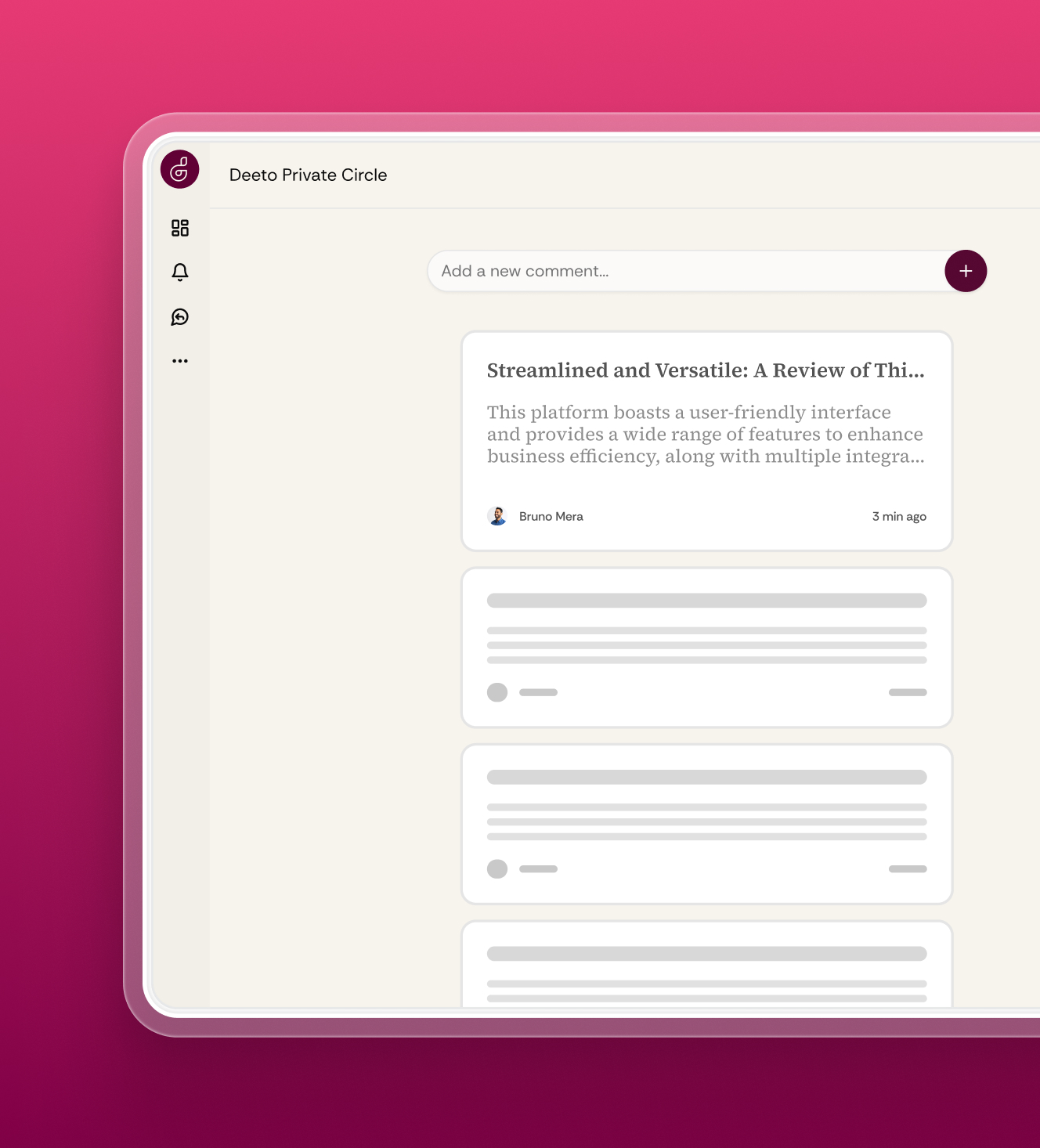
Discover practical guides, templates, and tools to help your team close more deals, faster.
Your customers receive hundreds of marketing messages every day. Most of them get ignored, deleted, or forgotten within seconds.
But some messages break through the noise. They spark conversations, build relationships, and turn prospects into loyal advocates.
The difference? Customer engagement marketing.
Instead of broadcasting one-way messages, engagement marketing creates two-way conversations. It focuses on building meaningful connections that keep your audience coming back for more.

Customer engagement marketing is an approach that focuses on creating meaningful interactions between your brand and your customers. Instead of pushing generic messages, you invite customers to participate in conversations, experiences, and relationships.
You build these connections through interactive content, personalized communications, and community-building initiatives. This turns marketing from a one-time transaction into an ongoing relationship.
Winning a customer is just the beginning. The real growth happens after the sale, when you turn customers into loyal users, advocates, and repeat buyers.
That’s the role of customer engagement marketing. It’s how you nurture relationships, deliver ongoing value, and deepen trust after someone’s already using your product.
There are a few reasons to invest in engagement-first customer marketing, specifically:
Engagement marketing transforms customers from passive recipients into active brand advocates. When you consistently provide value and foster genuine connections, customers develop emotional attachments to your brand.
These relationships run deeper than transactional exchanges. Engaged customers become invested in your success because they see you as a partner, not just a vendor.
They're more likely to recommend your services, defend your brand against competitors, and give you the benefit of the doubt when challenges arise.
Customer marketing is one of the best levers for new customer acquisition. In fact, more than 90% of today’s B2B buyers trust peers in their industry, while fewer than 1 in 3 trust company sales reps.
The faster you can activate more of your customer base, the more deals you’ll close, which is why a personalized, engagement-first approach is so critical here.
At the same time, engagement marketing is a solid retention lever because buyers have more options, shorter attention spans, and higher expectations than ever before. In most categories, product features are somewhat to entirely commoditized, so your main differentiators are (a) the customer experience you deliver and (b) your direct relationship with each customer.
Acquisition costs continue to rise across industries (2-12% in 2024 alone). Keeping existing customers costs several times less than finding new ones.
Engagement marketing strengthens the bonds between you and your current customers. You stay top of mind when they face new challenges. You position yourself as their go-to resource for solutions. And they don’t even think about exploring alternatives.
When customers are loyal, they’re more likely to upgrade services, purchase additional products, and renew contracts. Not to mention, they’re 31% more likely to pay a higher price.
When customers feel valued and understood, they view your products as investments rather than expenses and see the long-term benefits of maintaining the relationship. Meanwhile, you generate more revenue from each customer relationship while reducing the pressure to constantly onboard new accounts.
Although Google keeps pushing the timeline back, third-party cookies are definitely disappearing. Privacy regulations are tightening. Traditional tracking methods are becoming obsolete. Those trends aren’t going to revert.
Engagement marketing is the alternative path forward. Instead of relying on external data, you build direct relationships with customers who willingly share information. Customers engaging with your content and communities give you first-party data, which is more accurate, relevant, and actionable than cookie-based insights.
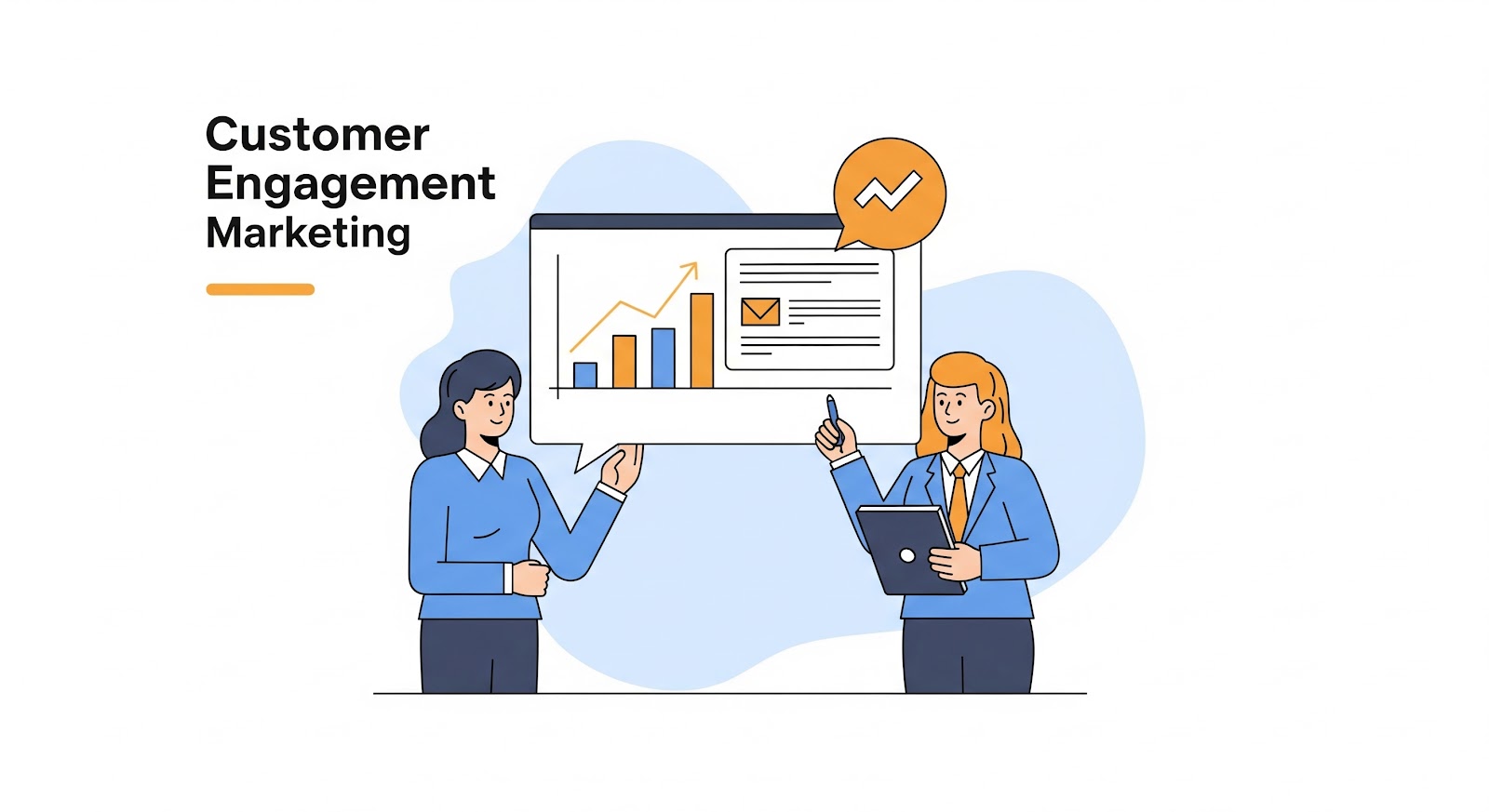
Traditional marketing follows a broadcast model. You create messages and push them out to large audiences through channels like email blasts, display ads, and cold outreach.
Engagement marketing flips this dynamic by creating opportunities for two-way conversations. Customers become active participants who shape the experience.
With traditional marketing tactics, you’re treating customers as passive recipients. You talk at them, hoping something sticks. Success gets measured by impressions, clicks, and immediate conversions.
Instead of interrupting people with your message, engagement marketing is about providing value that draws them in. You focus on building relationships that generate long-term results rather than quick wins.
When you implement engagement marketing effectively, you create a win-win scenario. Your business achieves better results while your customers receive superior experiences.
The benefits compound over time. Each positive interaction builds on the last, creating momentum that drives sustainable growth.
Engaged customers convert at higher rates and spend more per transaction. They trust your recommendations because you've consistently provided value. When they're ready to buy, you're their first choice.
Satisfied customers become vocal advocates. They share positive experiences with peers, leave favorable reviews, and refer new prospects. Organic word-of-mouth marketing is more credible and cost-effective than traditional advertising.
Active engagement generates rich behavioral and Voice of the Customer (VoC) data. You learn what content resonates, which channels work best, and what product-related challenges your audience faces. These insights inform product development, marketing strategies, sales workflows, and business decisions.
While competitors focus on features and pricing, you differentiate through relationships. Engaged customers are less likely to switch providers because they value the connection beyond your core product or service.
Customers receive content, recommendations, and communications tailored to their specific needs and interests. This relevance saves them time and helps them make better decisions.
Regular engagement demonstrates that you care about their success, not just their wallet. This emotional connection builds trust and loyalty that transcends business transactions.
Engagement marketing creates cohesive experiences across all touchpoints. Customers can easily find information, get support, and take action without friction or confusion.
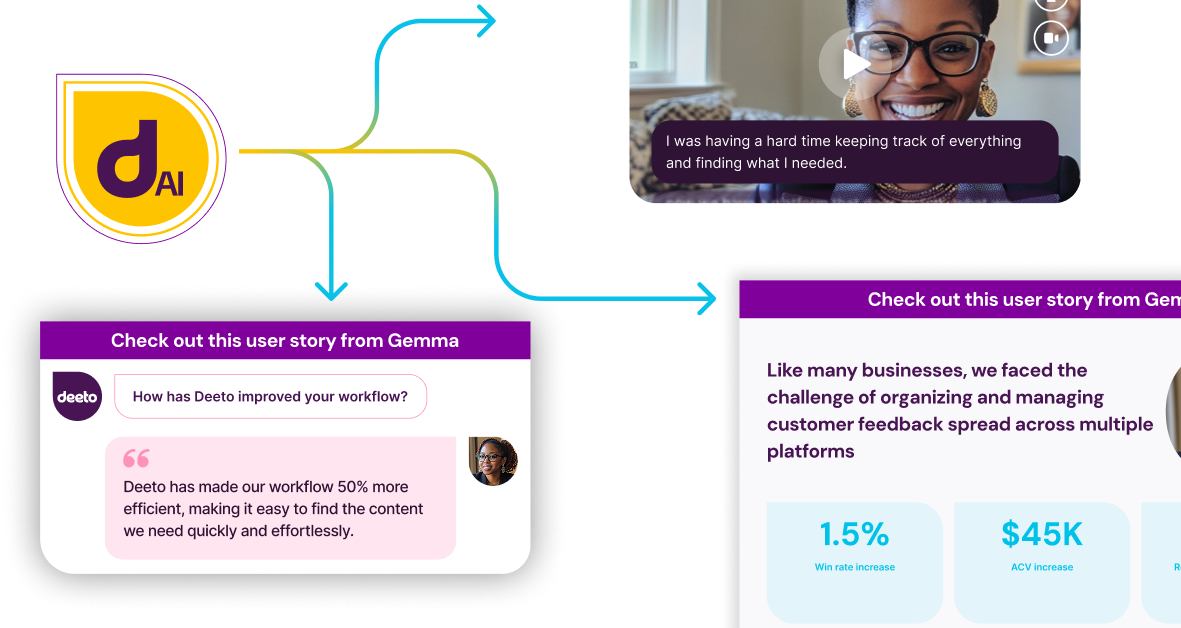
Building a successful engagement marketing strategy requires you to focus on several core elements at once. These four pillars work together to create meaningful connections that drive results.
Master these fundamentals, and you'll have the foundation for sustainable customer relationships that fuel long-term growth.
Personalization transforms generic experiences into tailored journeys that feel crafted specifically for each individual. Your existing customers have already shown trust in your brand, now you need to honor that trust with relevant, meaningful interactions.
You can start by:
Pro tip: Use a platform like Deeto to personalize your customer advocacy experience as well. Customers onboard themselves, choose their communication and contribution preferences (e.g., testimonial vs. case study vs. reference calls), then the platform connects them with advocacy opportunities that align with those preferences.
Customers want real, consistent communication from a brand they trust. The way you communicate through content, campaigns, and conversations should reflect your company’s values and your commitment to your customers’ success.
You can master authenticity by…
Feedback loops are the “engagement” half of customer engagement marketing. This is how you create an open dialogue with your customers, then implement the marketing and product changes they’re looking for. If you want users to actively participate in your brand, you need to participate with them.
To intentionally create opportunities for dialogue:
You can also repurpose customer feedback into additional marketing content, like social proof for your website or UGC for your socials.
“Continuous value delivery” means using what you learn from your customers to keep helping them succeed long after the initial sale. If they’re hitting adoption roadblocks, you address them. If they’re asking for more advanced use cases, you show them the way. It’s an ongoing cycle of listening, improving, and delivering more value over time.
To them, this solidifies that your product and your team will keep growing with them, which turns them into long-term advocates and partners.
The pillars we’ve just covered give you the foundation. Now, it’s time to bring your engagement marketing to life through the tactics you use every day.
The goal is simple: keep delivering value, deepen relationships, and create moments that make your customers want to stay connected with your brand.
Here are some of the most effective customer engagement marketing strategies to help you do just that:
Your customers interact with your brand across email, in-app, social, events, and tons of others. They expect a seamless experience, no matter where they engage.
An omnichannel strategy ensures your messaging, tone, and value delivery stay consistent everywhere. This builds trust and makes it easier for customers to stay connected with you on their terms.
Pro tip: Map your customer touchpoints and identify gaps or inconsistencies. Then unify your messaging and personalization across channels.
Static content only goes so far. If you want to boost engagement, make your content interactive.
Think interactive product tours, quizzes, assessments, calculators, and clickable onboarding guides. These experiences pull customers in, encourage exploration, and drive stronger adoption and retention.
You can even use interactive content to guide customers toward the next step in their journey, whether that’s discovering a new feature or realizing the ROI of what they already use.
Communities (online forums, Slack groups, in-person events) give your customers a space to connect with each other, share ideas, and build loyalty to your brand, not just your product.
To win in the “community” category, facilitate peer-to-peer connections on your website, highlight top contributors, and stay active in the conversation to show you’re invested in the community’s success.
Your customers are your best marketers. Encourage them to share their stories, use cases, or creative ways they leverage your product. Then amplify that content across your marketing channels. It builds trust and inspires other customers to engage more deeply.
Find out how Deeto makes UGC easy to create, submit, and distribute.
Referral programs turn your happiest customers into advocates, while loyalty programs incentivize continued engagement and repeat purchases. Design a simple, clear program with rewards your customers actually want, and use a customer engagement platform (like Deeto) to make it easy for them to participate.
We touched on this earlier, but it’s worth reinforcing here. Beyond one-off surveys, create a consistent system for capturing customer input, sharing what you learned, and visibly acting on it. This shows customers that their voice matters and builds deeper trust.
To maximize the impact of customer engagement, close the loop publicly when you implement customer-driven changes. This way, feedback turns into a visible, positive story.
Real-time chat (live chat, in-app messaging) and AI-powered assistants help you meet customers where they are. It’s useful for answering FAQs, guiding them through onboarding, and suggesting next steps. Use it proactively to support feature adoption and reduce friction points in addition to reactive support.
Gamification taps into basic human motivators: progress, achievement, and competition. Adding game-like elements to your product experience (badges, progress tracking, leaderboards, milestones) encourages them to keep advocating and deepen their product usage.
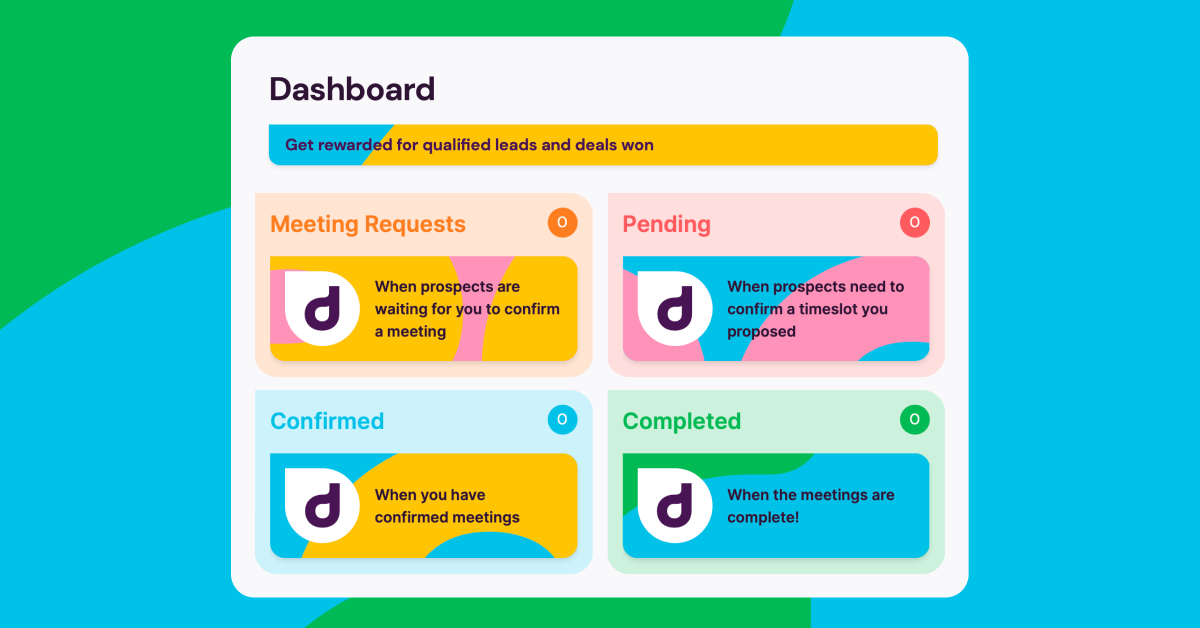
Deeto helps companies turn their happy customers into advocates who can influence prospects through trusted peer recommendations.
The core idea is to embed customer voices into your marketing and sales processes, making it easier for new prospects to trust and convert while simultaneously deepening your relationship with existing customers.
This covers all four engagement marketing pillars flawlessly:
Engagement marketing looks different in B2B and B2C because the customer journey, expectations, and relationship dynamics are fundamentally different. But the core goal is the same: build deeper, lasting relationships with your existing customers.
Longer relationships, deeper trust required.
B2B buying cycles are a lot longer (several months), and products normally require ongoing customer success. Engagement marketing in B2B focuses on turning customers into long-term partners and advocates.
Common strategies include:
The main priority is to increase trust, reduce churn, and turn customers into high-value advocates who influence new buyers.
Faster cycles, emotional loyalty wins.
B2C brands generally have larger customer bases with lower CLV and shorter buying cycles. Engagement marketing here focuses more on emotional loyalty, lifestyle alignment, and repeat purchases.
Common strategies include:
The goal is to keep customers coming back and to amplify word of mouth through shareable experiences.
Now… great marketing of any kind is about execution. And to execute well, you need the right tools.
The right platforms can help you personalize interactions, automate engagement at scale, and turn your customers into advocates. They also give you the data and feedback loops you need to keep improving.
These are the four essential categories of tools to support your engagement marketing efforts:
Customer engagement platforms give you a centralized way to manage interactions across the entire customer lifecycle. They help you track product usage, trigger personalized messaging based on behavior, and orchestrate campaigns that drive retention and expansion.
Look for one that integrates tightly with your CRM and product data, so you can act on real-time customer signals.
Modern CRM systems like Salesforce, HubSpot, and Pipedrive allow you to track customer interactions post-sale, segment your customer base, and coordinate personalized outreach across teams (marketing, success, support).
Your CRM should integrate with practically every other touchpoint, so you can build a holistic profile of each customer. Enrich your CRM with product usage and support data to drive more relevant engagement at every stage.
Automation is what makes engagement marketing scalable.
With tools like marketing automation platforms (Marketo, HubSpot, Customer.io), you can create personalized journeys based on customer behavior — onboarding flows, feature adoption nudges, win-back campaigns, and dozens of others.
Of course, you have to balance automation with authenticity. The goal is to scale relevant, helpful engagement, not generic messages.
Your customers’ voices carry more weight than your marketing ever will. That’s why social proof and referral platforms are so powerful.
Deeto helps you operationalize advocacy. It turns customer reviews, testimonials, referrals, and success stories into usable sales and marketing assets that drive further engagement and growth, both for program participants and the prospects in your pipeline.
To get the most out of these tools, don’t just collect social proof. Make sure to weave it into your marketing, onboarding, and sales processes to continuously reinforce trust and drive product value.
Deeto helps you turn your best customers into your most powerful marketing engine, all while deepening engagement and loyalty among your existing customer base.
By making it easy to capture authentic customer stories, drive referrals, and embed social proof across your entire customer journey, Deeto keeps your brand human and your customers actively involved.
It’s a simple way to amplify the impact of everything you do in engagement marketing.
Want to see Deeto in action? Request a demo today.

Discover what customer engagement marketing is, why it matters, and explore strategies with practical use cases.
The B2B buyer’s journey isn’t a straight line. It’s a complex, multi-stage process that involves research, collaboration, risk assessment, and (often) a long list of decision-makers.
Unlike in B2C, where a single person can make a spontaneous purchase, B2B buyers move through stages with intent, deliberation, and internal consensus. They’re not just buying a product but investing in a solution that impacts their team, budget, and business outcomes.
If you want to sell to other businesses effectively, you need to understand how your buyers think, what they need at each step, and who’s influencing their decisions behind the scenes.
In today’s guide, we’ll go over all of that and more.
The B2B buyer journey is the path your B2B customers take from the moment they realize they have a problem to the point where they choose a solution (ideally, yours). It encompasses multiple stages and touchpoints across several decision-makers, and it takes weeks or even months.
Compared to B2C, B2B buying is:
For businesses, purchase decisions are about solving a business challenge, reducing risk, and aligning with internal stakeholders. As a vendor or seller, your job is to understand it well enough to support your buyers every step of the way.
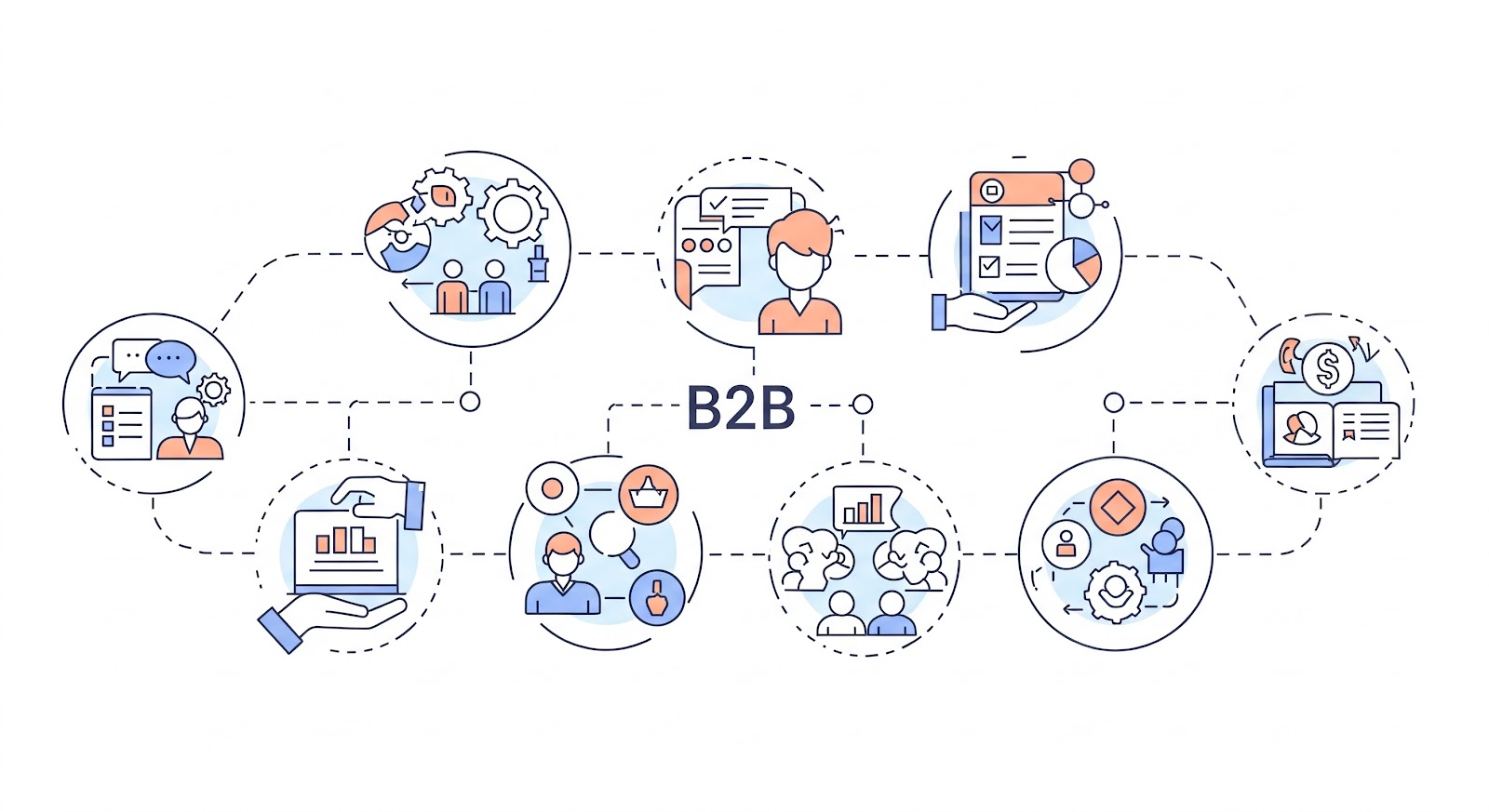
The B2B buyer journey in 2025 looks nothing like it did ten years ago. Today’s buyers are independent, digital-first, and harder to reach through traditional channels.
Buyers don’t wait for a sales call to get answers, they go get them themselves.
From start to finish, data from Gartner shows that B2B buyers spend only 17% of their total purchase journey talking to sales reps. That’s split between all vendors, so your company’s individual impact is actually less than 5%.
According to 6sense’s 2024 Buyer Experience Report, the typical buyer is ~70% through the decision-making process by the time they reach out, and 8 in 10 buyers initiate contact with a vendor, not the other way around.
Buying committees are also bigger and more cross-functional. A marketing director might start the search, a procurement officer joins halfway through, and a C-level exec signs off at the end. 6sense’s report revealed that the average buying group now has 11 people.
Not every step leaves a data trail. Buyers now rely on what we call “shadow channels” — places like Slack groups, LinkedIn DMs, Reddit threads, private WhatsApp chats, and niche professional communities.
You won’t see these interactions in your CRM or website analytics. But they’re powerful.
A buyer may ask for honest feedback about your product in a RevOps Slack community. That word-of-mouth matters more than your website or ad copy, and you’ll never know it happened unless someone tells you.
AI helps buyers move faster, analyze more options, and customize their research. Tools like ChatGPT, Perplexity, and buyer-focused comparison engines let users summarize pages of research in minutes.
At the same time, growing privacy regulations and tools like email blockers or cookie restrictions mean less visibility for you, the vendor. Anyone can now research anonymously, and you may not even realize they’ve engaged with you until they’re ready to talk.
For instance, a VP of Sales could generate a vendor comparison table with ChatGPT, read anonymized G2 reviews, and only reach out once they’ve narrowed their list to two options, without ever downloading a whitepaper or filling out a lead form.
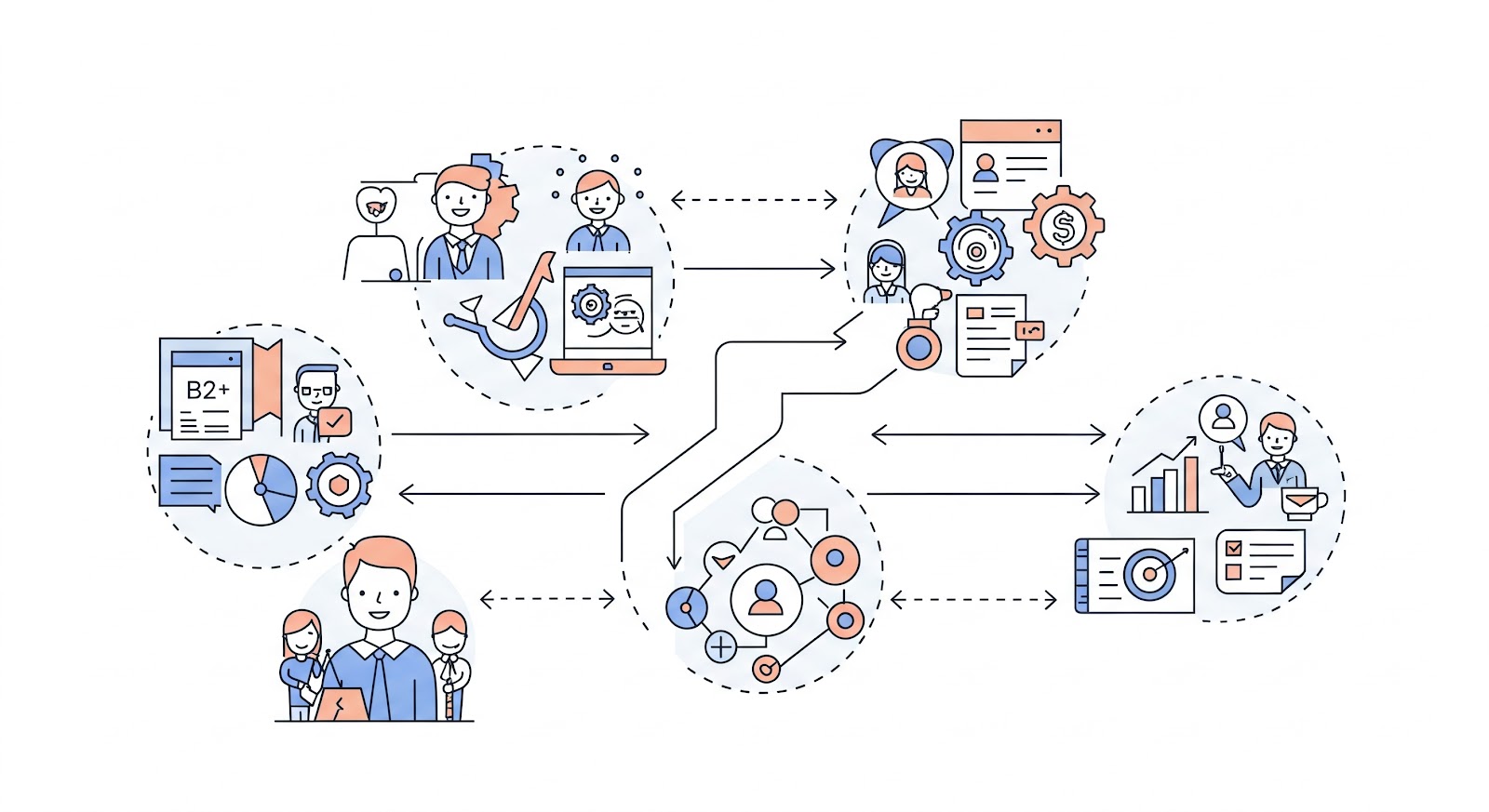
To understand how to sell better, you need to think like your buyer. Every B2B purchase follows a general path from first recognizing their problem to becoming a loyal advocate. Each represents real shifts in mindset, behavior, and internal discussions happening behind the scenes.
The Awareness stage begins when something triggers your buyer to recognize a problem or opportunity.
Maybe their team is wasting hours on manual reporting. Maybe their old vendor just raised prices. Maybe they read about a competitor adopting new tech. Whatever it is, it sparks curiosity, and then research.
Buyers start Googling, reading blog posts, asking peers, and exploring industry forums. They're not looking for you yet, but they are looking to define the problem and understand what’s possible.
At the Consideration stage, the buyer knows what kind of solution they need. They’ve named the problem and are narrowing their options.
This is when they compare categories (e.g., custom development vs. no-code tools), gather peer input, and begin to understand how different vendors solve their problem in different ways.
This stage is all about education and validation. Buyers here will…
A RevOps leader evaluating CPQ tools might compare DealHub, Salesforce CPQ, and PandaDoc based on features, usability, integrations, and customer support.
By the time a B2B buyer reaches the Decision stage, they’ve made a shortlist. Internal alignment becomes the priority.
This is where trust, clarity, and support matter most. Buyers will…
Even if the primary buyer loves your product, they still need buy-in from finance, IT, legal, and sometimes the C-suite. Expect pricing conversations, security reviews, reference calls, and a lot of back-and-forth.
Successful sales reps use a methodology like MEDDIC to adapt to each buyer’s needs here.
The journey doesn’t end when the contract is signed. Your buyer now becomes a user, and your job is to help them succeed. Onboarding, product adoption, and ongoing support determine whether they’ll renew, upgrade, or churn.
This stage is your best chance to turn customers into long-term advocates. They’re going to measure the product’s impact against expectations. If the value is there, you can get them to recommend your product to others.
You can’t improve the buyer journey if you don’t understand it.
Mapping the B2B buyer journey means breaking down how prospects actually experience your brand, from the first moment of awareness to becoming a customer (and beyond). It’s the foundation of effective marketing, better sales alignment, and a smoother customer experience.
Here’s exactly how to do it, step by step:
Start by talking to real buyers. You need their perspective, not just your assumptions.
Set up structured interviews with recent customers, lost deals, and long-term users. Focus on uncovering their actual thought process. What triggered their search? What confused them? What built trust (or broke it)?
Ask open-ended questions like:
Track product adoption as well, and survey/interview your customers after they’ve been using your product for about three months. That’ll reveal the real value your product delivers (which is often different from what you market) and what onboarding friction they experienced.
Pro tip: Review transcripts with an AI tool like Grain, Gong, or Fireflies.ai to surface patterns in objections, language, and turning points. You’ll uncover what humans miss, like emotional cues or timing gaps.
Now, trace every single interaction a buyer has, all the way from when thye’re doing anonymous research to when they sign the deal.
Look at both digital and human touchpoints. Track website visits, ad clicks, downloads, webinar attendance, emails opened, and chatbot conversations, as well as sales calls, Slack intros, LinkedIn DMs, and in-person meetings if there are any.
Plot this out chronologically using a tool like Lucidchart or Miro to visualize the flow.
Make note of:
Certain aspects still might not be clear, so it’s a good idea to reverse-engineer closed-won deals in your CRM. Identify which paths are most common for high-LTV and high-CVR customers. You may find your best buyers never click ads, but often attend events or come via referrals.
This is where most companies fall flat. They have great content, but it's not aligned with where the buyer is mentally.
Each stage of the journey demands different types of messaging:
Since you probably already have existing content, audit it and tag each asset to a journey stage. You’ll likely find gaps (e.g., lots of top-of-funnel blog posts but no decision-stage material). Fill them strategically with the format and channel your buyers prefer.
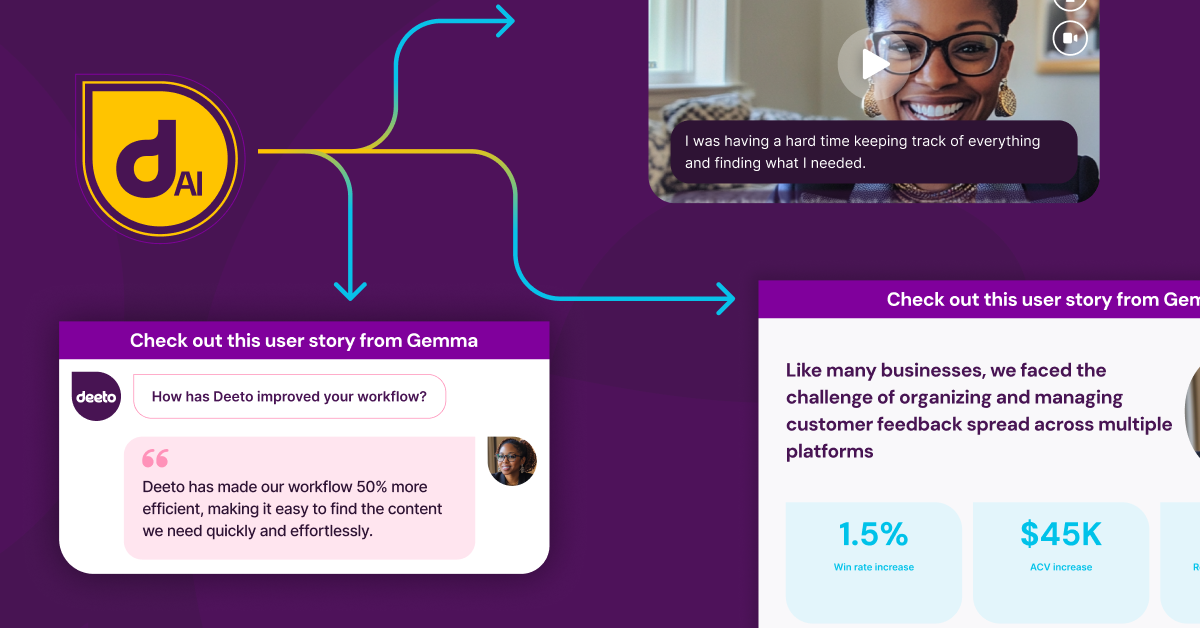
Forrester data reveals something we’ve known for what feels like forever: most B2B buyers (90%+) trust peers in their industry, while almost none (29%) trust vendor sales reps.
That’s why customer advocacy software is such a game-changer. Deeto lets you bring the Voice of the Customer into the buyer journey earlier through embedded customer stories, testimonial carousels, and even on-demand reference calls.
Use it to:
On top of that, Deeto’s AI-powered smart-matching and dynamic display algorithms allow you to dynamically serve social proof by industry, company size, or buyer role. This makes every interaction feel personalized, even before sales gets involved.
Even if you understand the buyer journey inside and out, executing against it is a different story. Modern B2B buyers are unpredictable, independent, and skeptical, so some businesses struggle to keep up.
Here are four of the most common challenges we see even experienced teams get tripped up by:
Your CRM might tell you a lead came from a demo request. But the buyer? They first heard about you in a Slack group, Googled you a week later, lurked on your founder’s LinkedIn posts for a month, clicked a retargeting ad, and then filled out the form.
Linear attribution models (like first-touch or last-touch) miss this completely.
Solution: Shift your mindset from precision to pattern recognition. Use blended attribution models and supplement with qualitative inputs.
Your buyer is on one journey. But too often, your teams act like they’re on three different ones.
Marketing optimizes for leads, sales pushes for pipeline, and CS handles the post-sale. A disconnect leads to drop-offs, mixed messages, and frustrated customers.
Solution: Build your buyer journey together, and operate around shared goals.
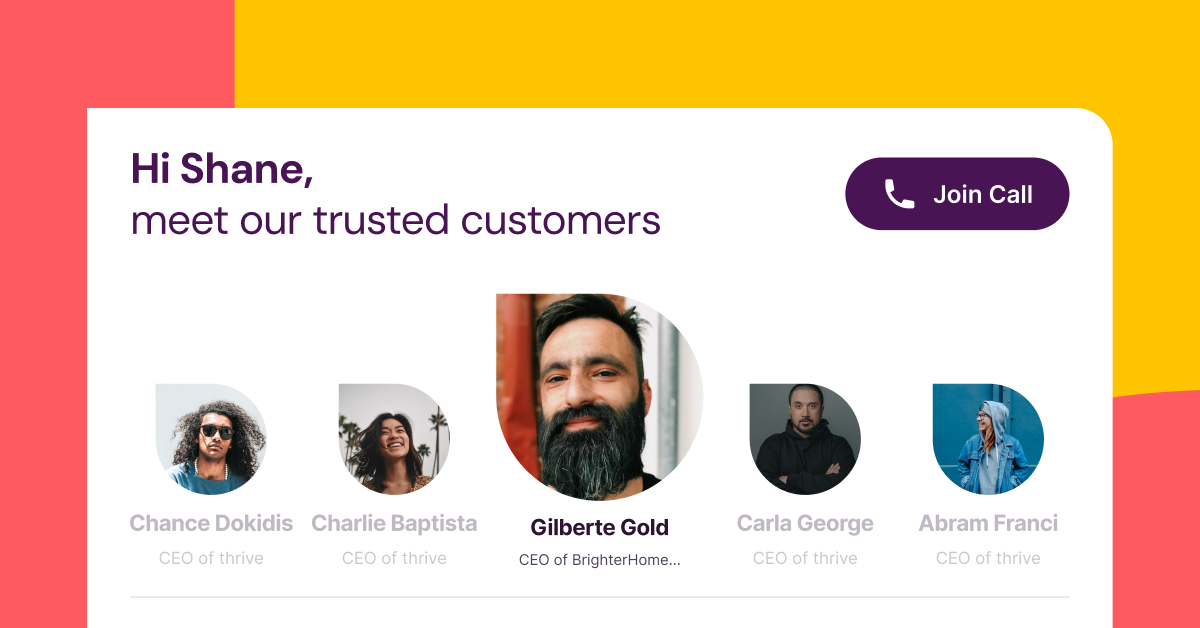
Today’s buyers expect tailored experiences, with 86% showing preference for 1:1 marketing. But lots B2B interactions still feel generic: same emails, same decks, same pitch.
That’s a trust killer.
If a FinTech CMO sees the same pitch as a Head of Ops at a logistics startup, they’ll both tune out.
Solution: Inject personalization and proof at every stage.
If every helpful resource is locked behind a form, you're slowing down the journey.
Modern buyers don’t want to talk to sales before they’re ready, and they’re skeptical of anything that looks like a trap (like requiring an email just to read a pricing doc). So, if all your content is gated, you’ll all but guarantee it won’t get read.
Solution: Collect emails for high-intent bottom-of-funnel content (e.g., a “free site audit” offer). Un-gate the rest.
One of the biggest mistakes we see companies make in B2B sales and marketing is treating the buyer journey as though it only concerns that specific team.
In reality, the buyer journey touches every team: marketing, sales, customer success, product, even finance and support. If each department is using its own version of the journey, the buyer ends up experiencing a fragmented, confusing process.
To fix that, you need tight alignment. That starts with shared visibility and continuous feedback.
Don’t build five versions of the journey. Build one.
Your single journey map should outline:
This map becomes your company’s shared source of truth. Everyone—from your SDRs to your onboarding specialists—knows where they fit and how their actions impact the buyer experience.
Alignment doesn’t happen through documentation alone. It’s built through ongoing, structured communication around what’s happening with buyers.
Broadly speaking, this is what strong feedback loops look like:
Trust is the biggest barrier in B2B sales, and customer advocacy helps you break through it.
When a buyer comes through a cold channel, they need to verify everything. Is this the right kind of tool? Will it integrate with our stack? Do others like us use it? Can we trust this company to follow through?
But when a prospect enters your funnel via a referral or peer recommendation, they already have those answers. They've skipped the doubt. They've skipped the skepticism. And often, they've skipped the first few micro-stages of the buyer journey altogether.
They already know:
That means you can bypass early education and move straight to relevance. You can tailor your content and conversations toward ROI, implementation, and decision-making, because the "should we trust this brand?" conversation is already handled.
Instead of hoping someone mentions you in a Slack group or refers you over coffee, Deeto turns social proof into a proactive part of your go-to-market strategy.
It helps you:
Want to see it in action? Request a demo and we’ll show you how it fits into your buyer’s journey.

Explore the 2025 B2B buyer journey, key stages, mapping steps, and trends to align your GTM teams and boost conversion.
Today is a milestone moment for Deeto. We’re thrilled to announce our $12.5 million Series A, led by Jump Capital with participation from UpWest, TAL Ventures, Mertor, TAU Ventures and a group of forward-thinking partners who share our belief: that the most powerful growth engine isn’t your product, pitch, or pipeline — it’s your customer.
At Deeto, we’re on a mission to turn authentic customer voice into structured, scalable, and revenue-driving insights. And now, with fresh capital and expanding momentum, we’re doubling down on building the future of how businesses earn trust, convert buyers, and inform innovation.
Why Now: Why Authentic Truth Has Become the New GTM Currency
Buyers have changed. They don’t want vendor-sourced promises. They want voices they can trust. They want to learn from people who’ve done it before them — on their own terms, in their own time.
But while buyer behavior has evolved, most go-to-market systems and processes haven’t. Static case studies, manual reference processes, siloed single point-in-time NPS scores, and customer stories buried in decks just aren’t enough anymore.
What today’s buyers need is the real truth, delivered in real time.
That’s why Deeto exists. We’ve built the only AI-native platform that helps companies activate the voice of their customers across every stage of the buyer and customer journey. And we’re only getting started.
What We Do: Turn Customer Voice into a Growth Engine
Deeto transforms how businesses collect, manage, and activate customer voice. Using our platform, companies like Atlassian, Dropbox, Klaviyo, Bloomreach, and 6Sense are able to:
The result?
What's Next: A Sneak Peak at Deeto 2.0
With our Series A, we’re accelerating into our next chapter: Deeto 2.0.
Deeto 2.0 isn’t just a new version of our platform — it’s a reimagined foundation for how companies scale trust, truth, and relationships in a post-AI, post-hype world. We’re moving from proof points to customer intelligence infrastructure.
To support this evolution, we’re introducing a new layer to our platform: Deeto AI Agents — purpose-built intelligence that helps teams go from insight to action without adding headcount.
These agents aren’t just automation for automation’s sake. They’re about scaling what’s real — the voices, insights, and stories that actually influence how businesses grow.
In a world where AI-generated content is flooding every channel, the only voice that cuts through is the one that’s real. The lived experience of your customers isn’t just a nice-to-have. It’s your most defensible advantage.
With this funding and momentum, Deeto is here to make that advantage accessible, scalable, and felt — everywhere it matters.
Stay tuned for more on the Deeto 2.0 front.
To our customers, partners, and new believers: thank you for trusting us to build something bold. If you’re ready to turn your customer voice into a competitive edge, reach out or follow us as we shape what’s next.
The future is customer-led. Powered by Deeto.

We're building the infrastructure to turn customer voice into a dynamic engine for trust, growth, and innovation.
“Content is king.” And in 2025, it’s the entire front half of your sales engine.
Last year, 6sense studied B2B buying behavior and released their 2024 Buyer Experience Report. In it, they revealed that buyers increasingly value autonomy in their purchasing process.
So, in most cases, the entire first half of the sales cycle happens before your sales reps can get a word in. Outbound alone won’t work. You need web content.
In today’s article, I’ll break down exactly which types of marketing collateral every B2B company needs to stay ahead this year.
Marketing collateral is any branded asset, digital or printed, that you use to promote your products or services and move prospects through your funnel. Examples include web content, social media posts, e-books, case studies, and demo videos.
There are a four main reasons to create and distribute marketing collateral:
Now, this isn’t just about making case studies and writing blog posts based off of a keyword list. It’s dynamic, digital, and strategically aligned with your customer journey. Every asset should serve a clear purpose: to move prospects closer to a “Yes.”
In B2B, single-person deals hardly exist. The average buying group includes 10 people, each of whom has their own priorities and pull in the decision-making process.
But, like I’ve already pointed out, most of their decision-making happens without you. Your sales rep won’t be in the room when they’re Googling solutions, comparing vendors, or presenting your pricing to the CFO.
That’s why your marketing collateral isn’t just support, it’s strategy.
B2B sales cycles can stretch from a month or two (for simple SaaS products) to 12+ months (for enterprise deals). That means you need a library of collateral that works at every stage of the funnel and speaks to every type of buyer.
Marketing today is zero-sum. When a buyer searches, only one brand gets clicked. If your content doesn’t rank, isn’t visible, or fails to answer their question, guess what? Your competitor’s does.
So your job is twofold:
We’ve made it clear: your buyers are doing the research with or without you. That means every piece of content you put out needs to work hard, speak clearly, and support different decision-makers across the funnel.
Strategically distribute enough of these seven kinds of collateral, and you’ll have a never-ending stream of MQLs that actually align with your ICP:
Before you impress anyone with your pitch deck or case study, your brand needs to look and feel consistent everywhere. That’s where your logos and brand guidelines come in. This is what guides everything from your sales PDFs to your LinkedIn graphics.
When done right, they:
Good news is, you don’t have to overcomplicate this. Even a basic brand kit (logo files, color codes, typography, and tone-of-voice guide) goes a long way.
Sales enablement collateral is the content your team uses to move prospects from "interested" to "ready to buy.”
These are the materials your reps share with prospects to help them make the right purchase decision.
But they’re not just for your sales reps. They’re for your buyers as well. They’re the ones forwarding your deck to their boss. They’re the ones pulling up your case study in a budget meeting. They’re the ones pitching your product for you.
You need to give champions inside your prospect’s company the tools to sell on your behalf. That means collateral that’s simple, skimmable, and laser-focused on value.
Digital marketing collateral is any visual or written content you use to promote your brand online and drive inbound traffic. It’s what fuels your demand gen engine and captures attention across social media, email, and paid ads.
Social media graphics stop the scroll and reinforce your brand on LinkedIn, Twitter, and even Instagram (yes, even for B2B). They reinforce your social proof and marketing content through short-form posts. Your employees should also use it on their profiles.
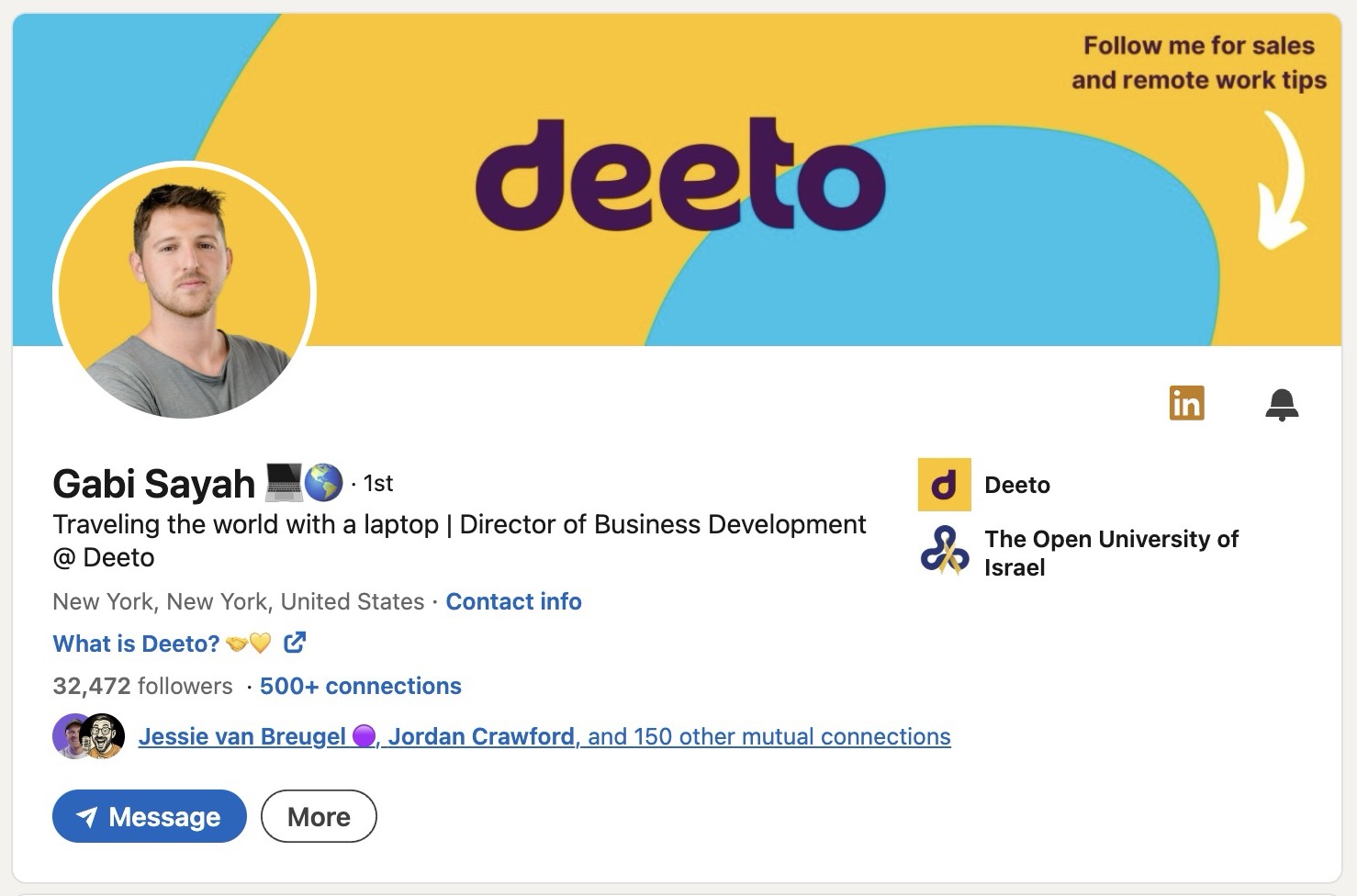
Email campaign templates are layouts you can use across newsletters, product updates, and nurture sequences. They should be mobile-friendly, skimmable, and designed to convert clicks.
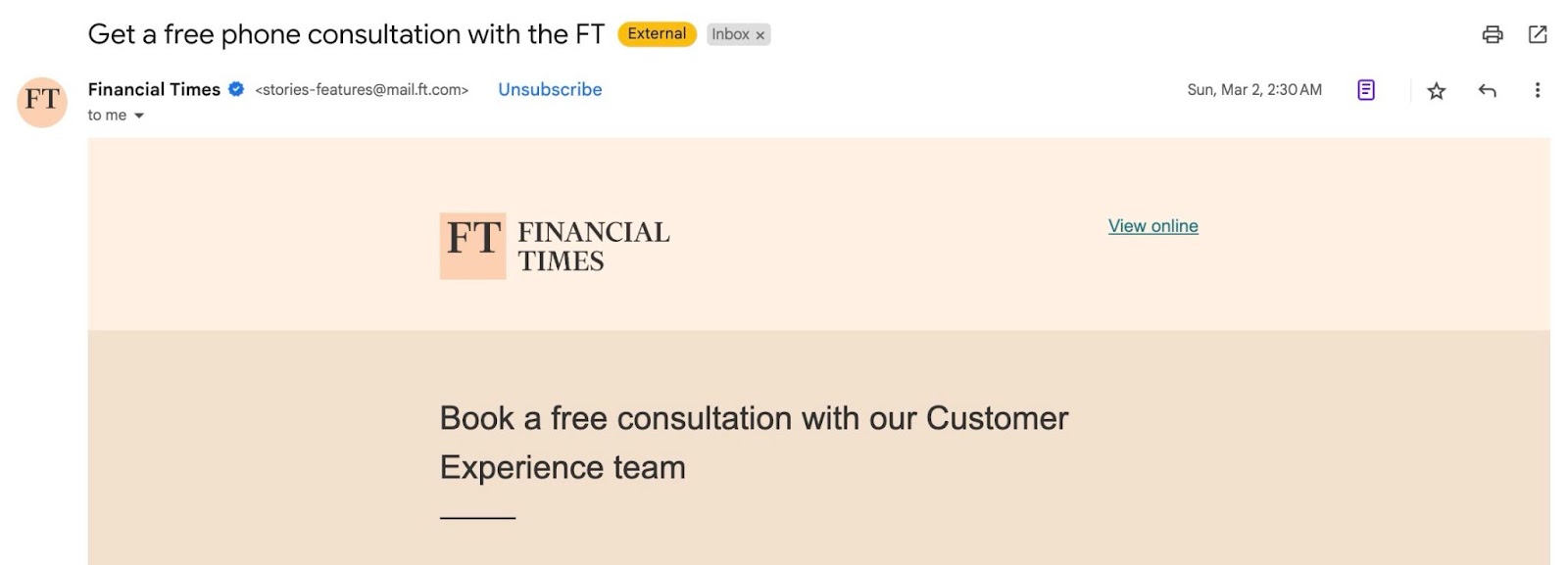
Digital ads like banner ads, retargeting visuals, and paid search graphics are similar to social media graphics, and they need to be tightly aligned with your landing pages to drive conversions.
For instance, this ad I just got for a new Qualtrics X Forrester report…
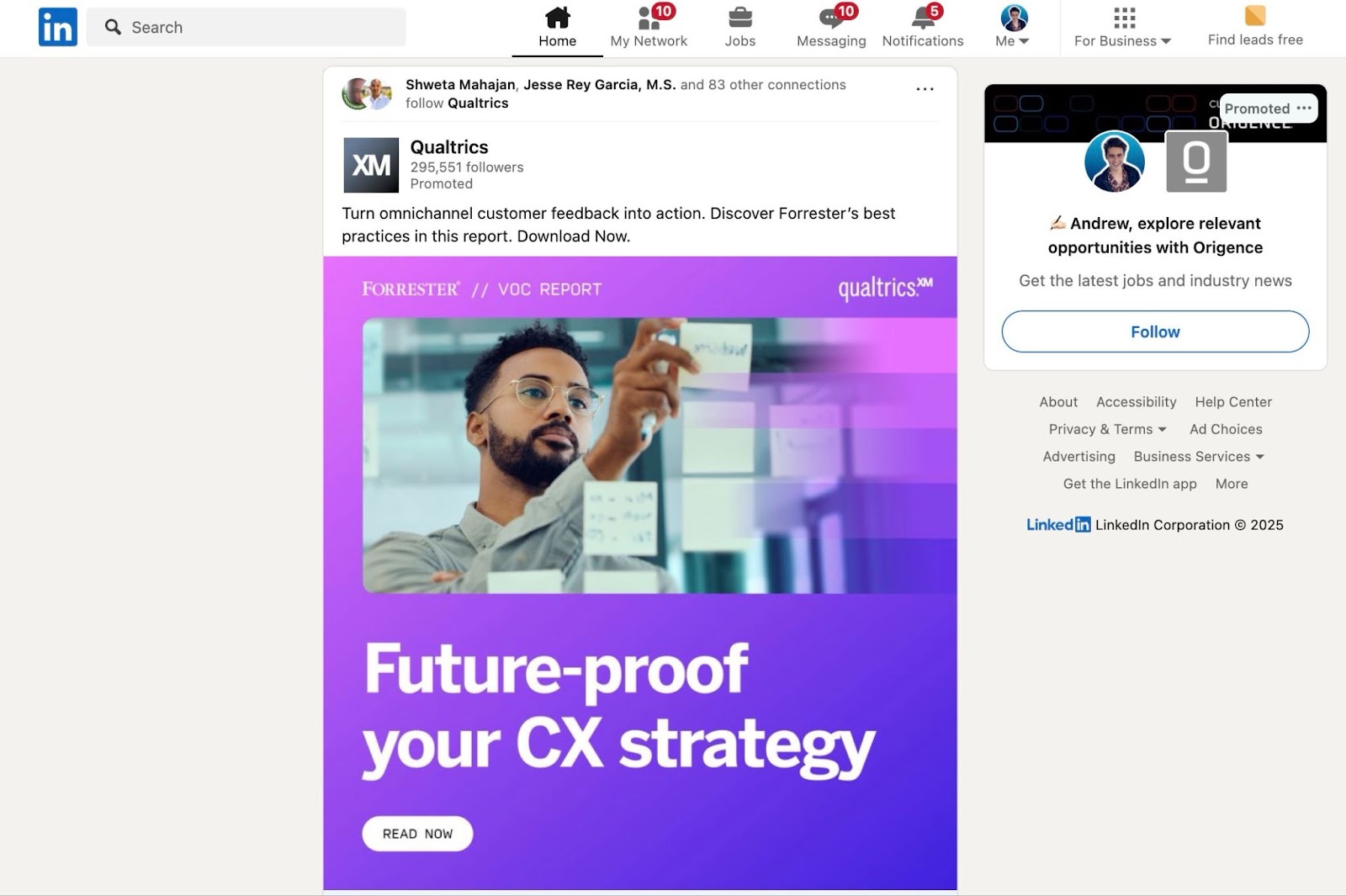
…matches Qualtrics’ website aesthetics perfectly.
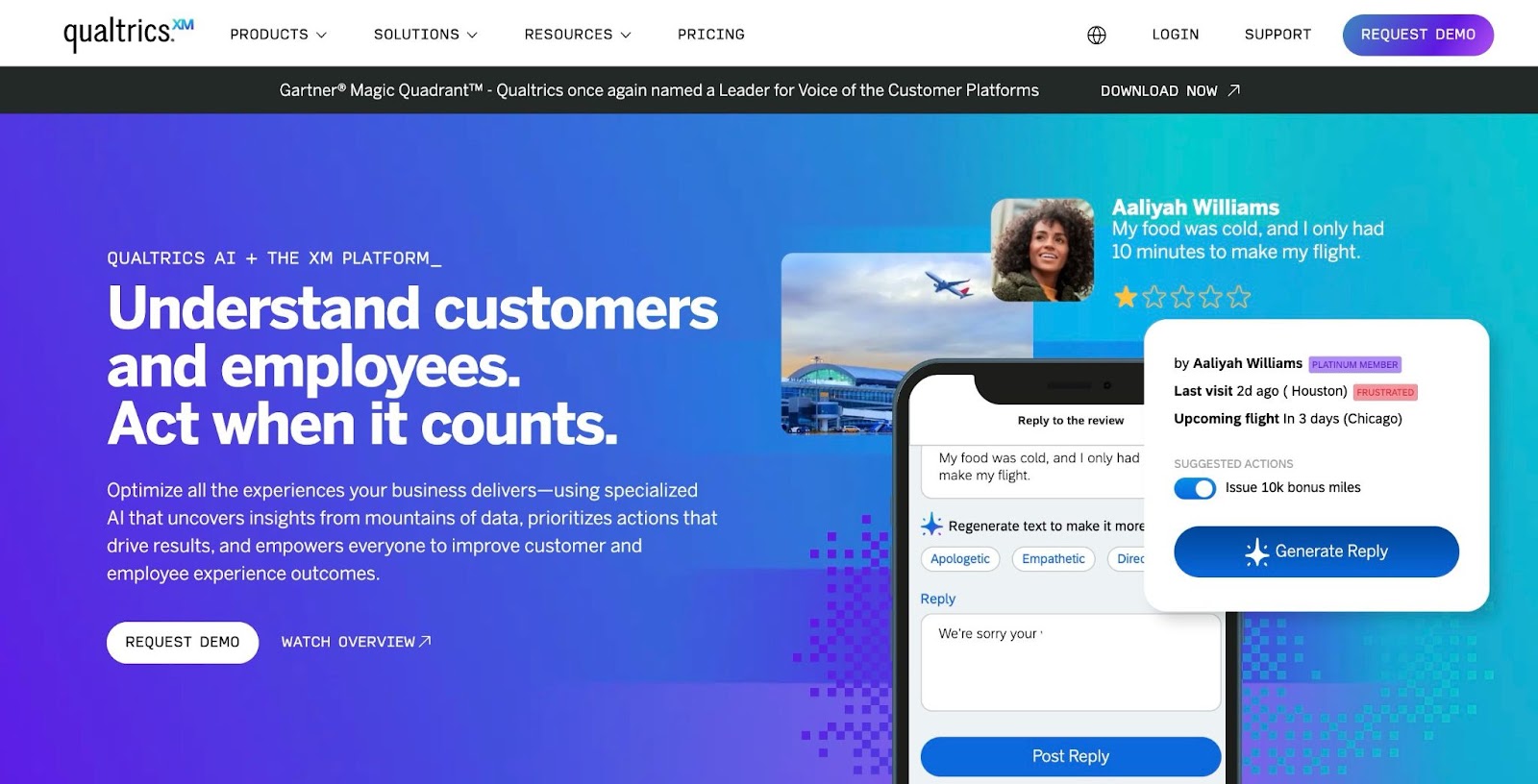
Even in a digital-first world, print still plays a role. You’re still showing up at events and in-person meetings, and print collateral is perfect for when you want to leave something behind that doesn’t get lost in someone’s inbox.
Today, though, most of your information is online. So it’s less about bulk brochures and more about high-impact, well-designed assets that feel intentional.
Keep these things short and visual, and include a QR code where your prospects can learn more.
This is the part of your marketing that people are actually reading. The things prospects find on Google or ChatGPT, bookmark, forward to colleagues, and use to justify buying your product. In fact, you’re reading ours right now.
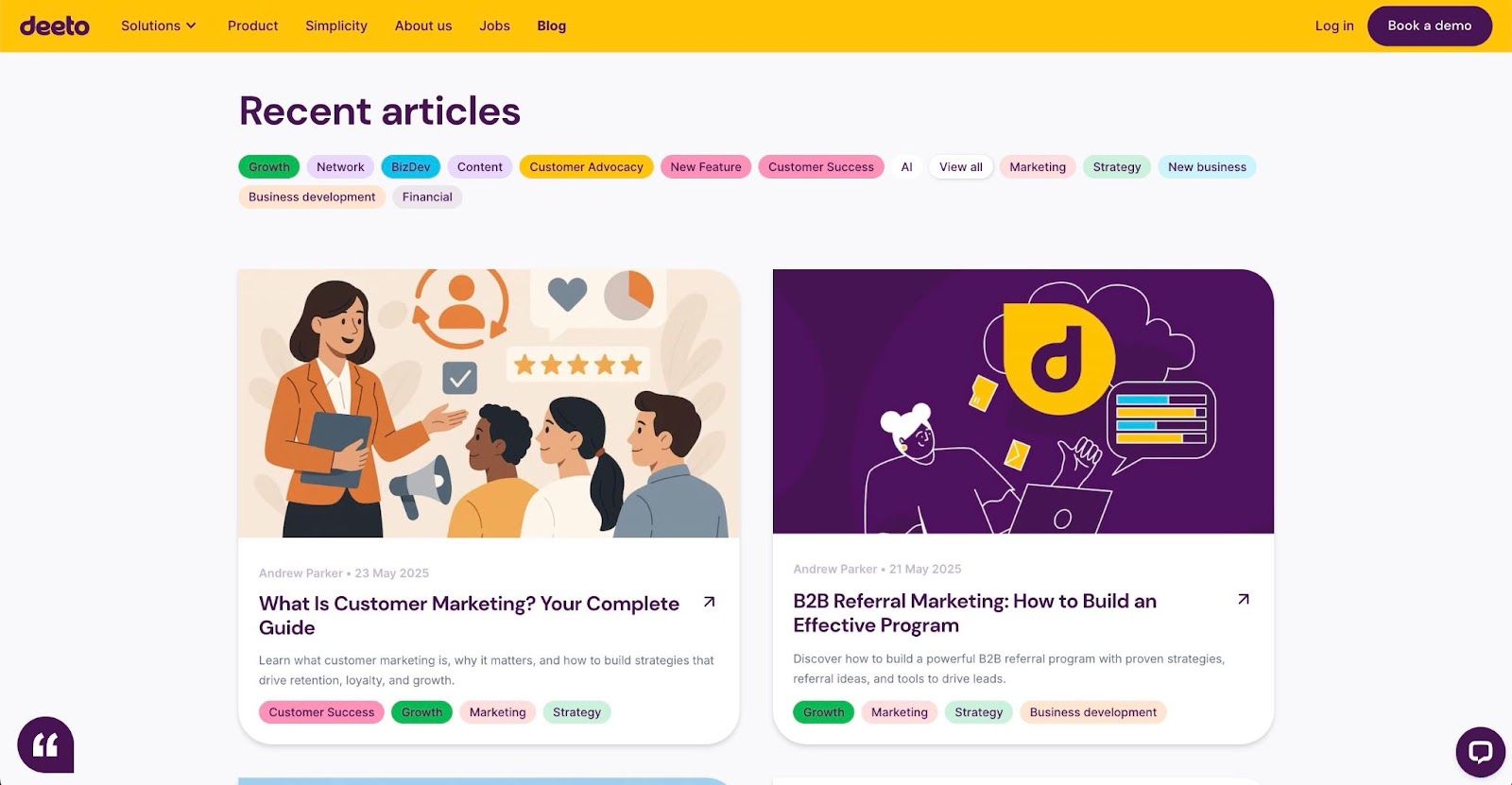
Content marketing sits at the core of your demand gen, lead gen, and conversion strategies. Some of it’s TOFU. Some of it’s BOFU.
A healthy mix of each will help you pique interest at the top of the funnel and nurture high-value leads up until they’re ready to book a call.
Event and trade show collateral is the physical and digital material you use to attract attention, communicate your value fast, and leave prospects with something they’ll actually keep.
It includes:
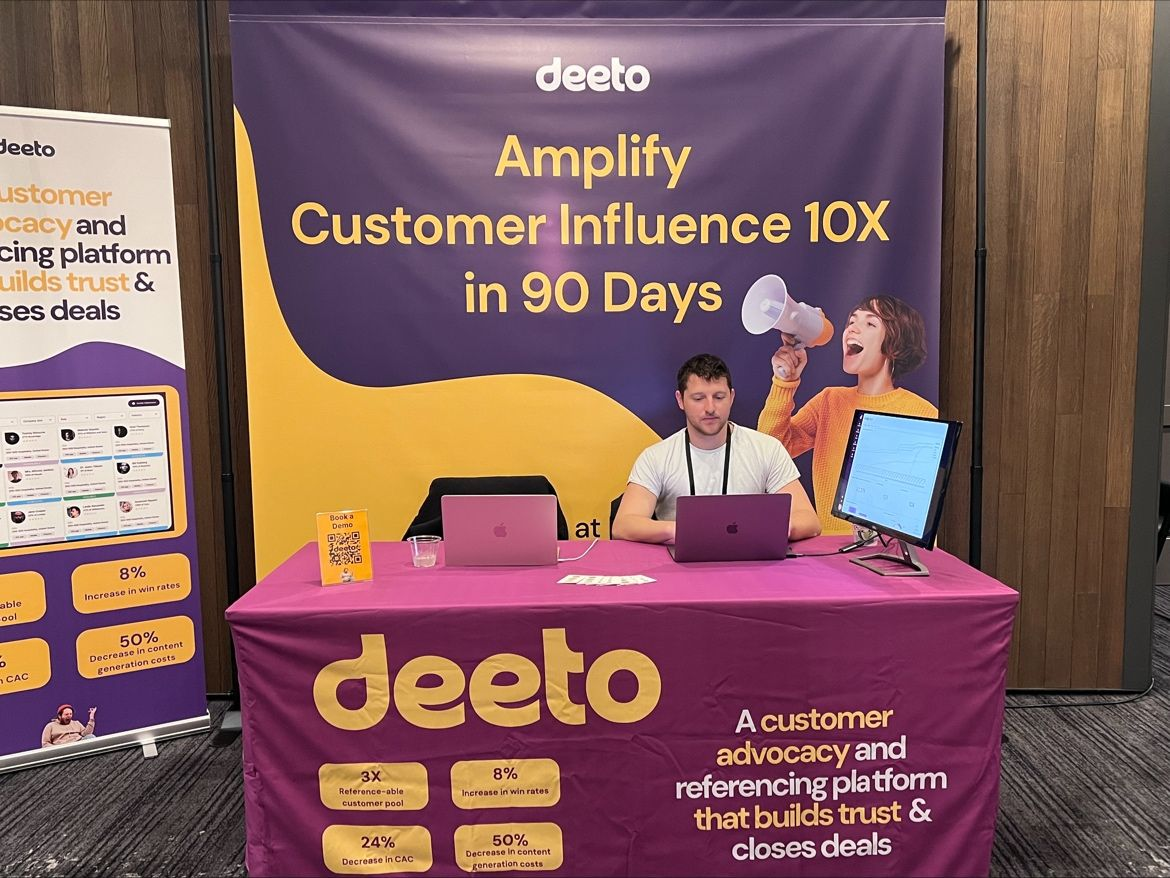
Just like with digital collateral, brands that blend bold visuals with clear messaging win.
Internal marketing collateral is the behind-the-scenes material that ensures your team knows how to talk about your product, share your message, and deliver a consistent experience, whether they’re in sales, support, or engineering.
A few of the things you’ll develop:
This kind of content helps you train, align, and activate your entire org so everyone’s pulling in the same direction.
Most marketing teams crank out assets just to “check the box.” They know they need it, so they post a few below-average blog posts, put up a few testimonials, and call it a day. Then they wonder why they don’t rank or convert.
If you want collateral that drives pipeline, closes deals, and makes competitors irrelevant, here are our six best tips:
Don’t just talk about features, reverse-engineer your content from the actual buying journey.
Ask: What’s happening in the buyer’s head at this exact moment?
Use real call transcripts, objection logs, and buyer enablement data to craft collateral that answers their internal questions within your content.
Smart marketers don’t make 100 new things. They make one killer asset and spin it 12 different ways.
Let’s say you write a whitepaper. From that, you can extract:
You can also repurpose customer feedback for marketing content. Using a platform like Deeto, you can collect input from your customers in the form of testimonials, product feedback, and results (e.g., ROI or a % increase in sales).
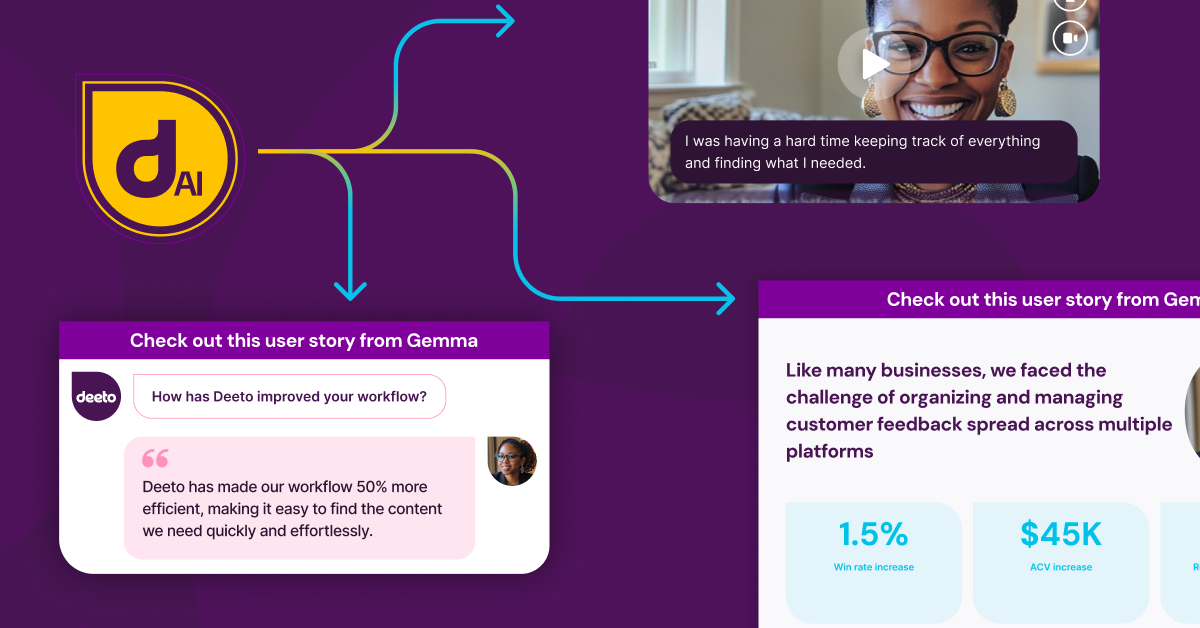
From there, our generative AI builds full case studies and clips use cases and testimonials you can distribute across your website and socials.
Too many marketers create for vanity. Real growth comes when every asset ties to one of three things:
Before you make anything, ask what metric it’ll move, then track it. If your new case study didn’t get shared by reps or downloaded by buyers, figure out why that type of content isn’t making a difference and what might be more effective.
You don’t need to personalize everything, but you should absolutely personalize the stuff that touches money.
Buyers will always respond better to something that feels like it was made for them.
No one is reading your 20-page PDF cover-to-cover. Design for skimming.
That means:
Remember: formatting is part of storytelling. Bad design makes good content invisible.
Great collateral evolves. A few simple habits, like setting quarterly reviews for core sales materials and centralizing everything in one source of truth (Deeto does this) makes all the difference.
It’s one thing to create great collateral. It’s a whole other to actually use it consistently, correctly, and across teams that rarely sync. Deeto simplifies that. It’s the platform you’ll use to activate your customer base, and it gives your entire team a single, organized place to store, manage, and share customer marketing content.
You can upload any type of file - PDFs, decks, videos, UGC, case studies, and tag it by persona, industry, or funnel stage. Built-in search and version control mean sales reps aren’t sharing outdated content, and marketing isn’t chasing down files before a launch.
It also makes collaboration easier. Sales, marketing, customer success, and product teams access the same library, and role-based permissions keep the system clean, and updates happen in real-time.
And with built-in AI tools, you can repurpose, distribute, and personalize marketing assets across your whole funnel without starting from scratch every time.
Want to see it in action? Request a demo today.

Discover must-have marketing collateral types and how Deeto helps store, organize & manage all assets in one smart place
Your customers are saying incredible things about you on G2.
Now, you can turn that praise into pipeline – automatically.
We're excited to announce a powerful new integration between Deeto and G2, launching as part of G2’s June 2025 Innovation Release. This partnership allows mutual customers to seamlessly bring their G2 reviews into Deeto, connect them to reference profiles, and publish them across marketing, sales, and customer advocacy channels – with full control.
Deeto helps turn customer voices into a strategic growth engine – by unifying reviews, references, testimonials, and customer stories in one platform. Now, with this new G2 integration, your best G2 reviews can automatically fuel every stage of the buyer journey – from discovery to deal close.
The Deeto + G2 integration makes it easy to:
It’s advocacy, made scalable – and deeply personal.
In today’s B2B landscape, buyers trust customers more than brands.
Yet most teams still struggle to bridge the gap between G2 reviews and their GTM strategy.
This integration solves that.
You’ve worked hard to build a strong presence on G2. This integration helps ensure those great reviews reach their full potential across the entire buyer journey. Here’s why this matters — for every part of your GTM team:
Customer Marketing
You already know the power of advocacy — but it’s time to scale it.
With this integration, you can easily turn G2 reviews into dynamic content across your programs: nurture streams, community content, reference hubs, and more — without manual work or copy/paste hacks.
Product Marketing
G2 reviews are packed with customer language and proof points.
Now, you can seamlessly bring them into your product marketing narratives: reinforce positioning, enrich launches, support competitive plays, and arm sellers with proof that resonates.
Sales Enablement
Buyers trust peers — but sellers often struggle to bring authentic customer voice into live deals.
This integration lets you surface the right G2 reviews at the right moment — personalized for deal stage, industry, or persona — to drive conversion and speed sales cycles.
CMO
You’ve invested in building customer trust — it’s time to turn that trust into pipeline and revenue.
This is an easy lever to expand your advocacy strategy, improve content ROI, and align marketing and sales around real customer proof — activated everywhere buyers engage.
You already earned your customer’s love.
Now, Deeto + G2 lets you fully leverage it.
All while keeping full control over what goes live and where.
This integration is available to mutual G2 and Deeto customers starting June 2025.
If you’re already a Deeto customer: Reach out to your CSM to activate — it’s quick and easy to enable. Available to G2 customers on Review Growth+Core, Growth+Core+BI, Growth+Core+Content, or those licensing G2 Content via Extra Impact. If you're unsure about your eligibility, we're happy to check with G2 on your behalf.
If you’re new to Deeto: Let us show you how Deeto + G2 can turn customer voice into your most powerful revenue driver. Book a demo here.
Your customers have already spoken on G2.
Together, we’ll help you make sure their voices are heard — and drive your next wave of growth.

Your customers are saying incredible things about you on G2. Now, you can turn that praise into pipeline– automatically.
Your customers are always talking. They’re constantly leaving reviews, replying to surveys, and commenting on social media.
But plenty of companies stop after collecting this information. And in doing so, they miss a major opportunity.
Your customer feedback isn’t just social proof. It’s content.
You can repurpose it into emails, ads, landing pages, videos, social media posts — any point in the purchase funnel where you need to build trust and drive decision-making.
In today's guide, you'll learn the what, why, and how of repurposing customer feedback into high-impact marketing content that works across every channel.
When potential customers see someone else solve the exact problem they’re facing, they lean in. It gives them confidence. It reduces friction. It answers the question: “Will this work for me?”
That’s what moves people from "maybe" to "I'm in."
You don’t need to hire a copywriter to guess what your audience cares about, though. Your customers are already spelling it out for you. You just need to capture it and turn it into content.
This is exactly why customer feedback is the most powerful tool in your marketing toolbox. When you start treating it as raw marketing material instead of something that's just "good to know," you create a consistent stream of trust-building, conversion-boosting content — content you can use to drive web conversions.
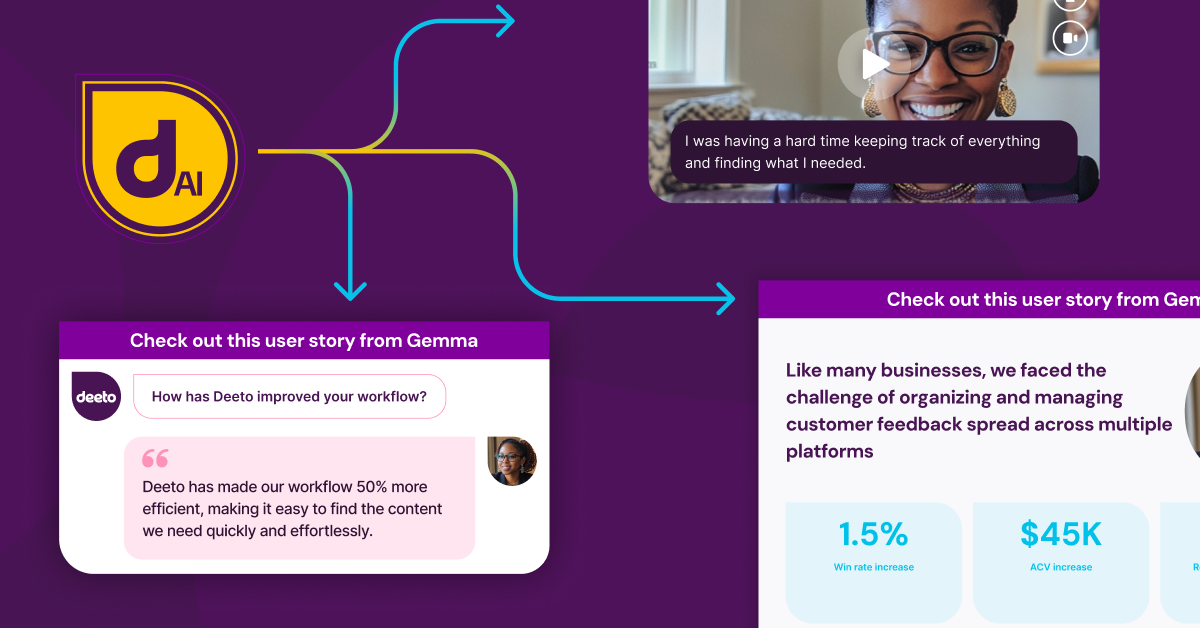
Repurposing your customer feedback is important because it turns real customer experiences into powerful, trust-building marketing content. It gives you credible, conversion-driving language straight from your audience, helps highlight what actually matters to your buyers, and keeps your messaging fresh without the guesswork.
In Neilsen's recent study of 40,000+ buyers across 56 countries, 88% said they trust customer feedback and recommendations over any other form of marketing messaging. After seeing a trustworthy review, 92% of B2B buyers are more likely to buy that product.
The reason is simple: When you use real quotes, language, and outcomes, you're not just telling people your product works, you’re showing them that it already has.
Your best customers say things in ways you never would’ve thought of. They describe pain points, benefits, and breakthroughs in the exact words your next buyer is probably already thinking. When you echo that language across your site, ads, and emails, it feels more personal.
You don’t need to start from scratch. Customer feedback is already flowing into your business through reviews, emails, support tickets, social posts, surveys, and calls. This makes it one of the lowest-effort ways to improve your content.
You might think people buy your product for Feature A. But what if your top customers all rave about Feature C?
Repurposing feedback forces you to zoom in on what your audience cares about, not what you think is important. That insight sharpens your messaging, your positioning, and your future product decisions.
Sales, support, and marketing teams all talk to customers differently. But when everyone pulls language and messaging from the same source (your customers), you create brand alignment. That means smoother pitches, stronger emails, and less “reinventing the wheel” across departments.
Stuck on what to post next on social? Need a new angle for your next ad campaign?
Customer feedback gives you an endless stream of ideas, quotes, and stories that are relevant, sharp, and close to the voice of your market. It’s like a living, breathing swipe file that updates itself.
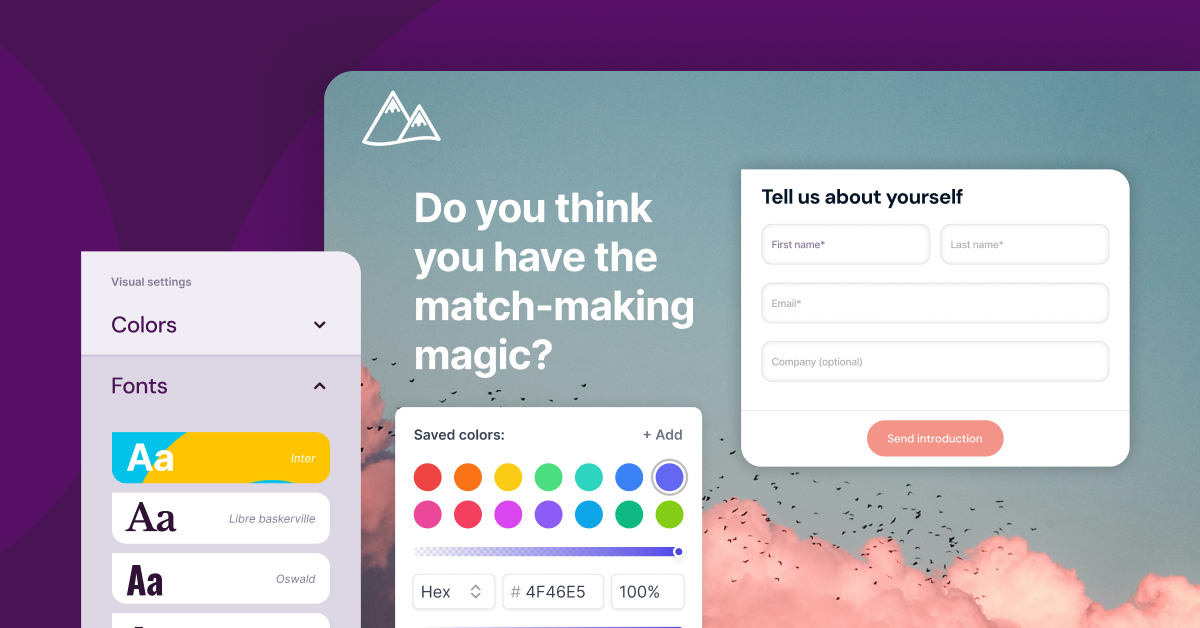
To actually reap those benefits, your first step is knowing where to look. Here are five high-impact sources of customer feedback, and how you can turn each into marketing gold:
Sites like G2, Trustpilot, and Google Reviews are the easiest sources of social proof to pull from, and they're some of the most powerful. They’re publicly available, and often written in your customer’s raw, unfiltered voice.
If you're using Deeto, our new Imported Contributions feature lets you push reviews across personal microsites (another Deeto feature for your sales team), G2 (via integrating the two platforms), and on-site widgets in seconds, without manual copy-paste.
Testimonials and case studies are deeper, more structured stories. They're perfect for turning one win into dozens of content pieces.
From a single testimonial or case study, you can extract:
Deeto’s AI-powered extraction feature makes the process easy. Upload a case study, and it automatically pulls out key moments, quotes, and summaries you can reuse instantly across channels.
This is how you scale social proof without creating from scratch every time.
When people tag you in a win, drop a comment about your product, or post a screenshot of their results, you’ve got powerful, organic validation.
Repurpose these into:
Bonus tip: You might be able to turn positive DMs into anonymous quotes if you can’t get public approval.
When someone messages support to say, “I finally figured this out—it saved me 4 hours,” that’s a conversion-ready quote.
Use those moments to:
To get these kinds of insights, talk to your support and success teams.
NPS responses tell you why people love you (or don’t). Surveys reveal what’s working and what’s missing. For your marketing content, look for recurring phrases, surprising praise, and moments of delight.
Repurpose that into:
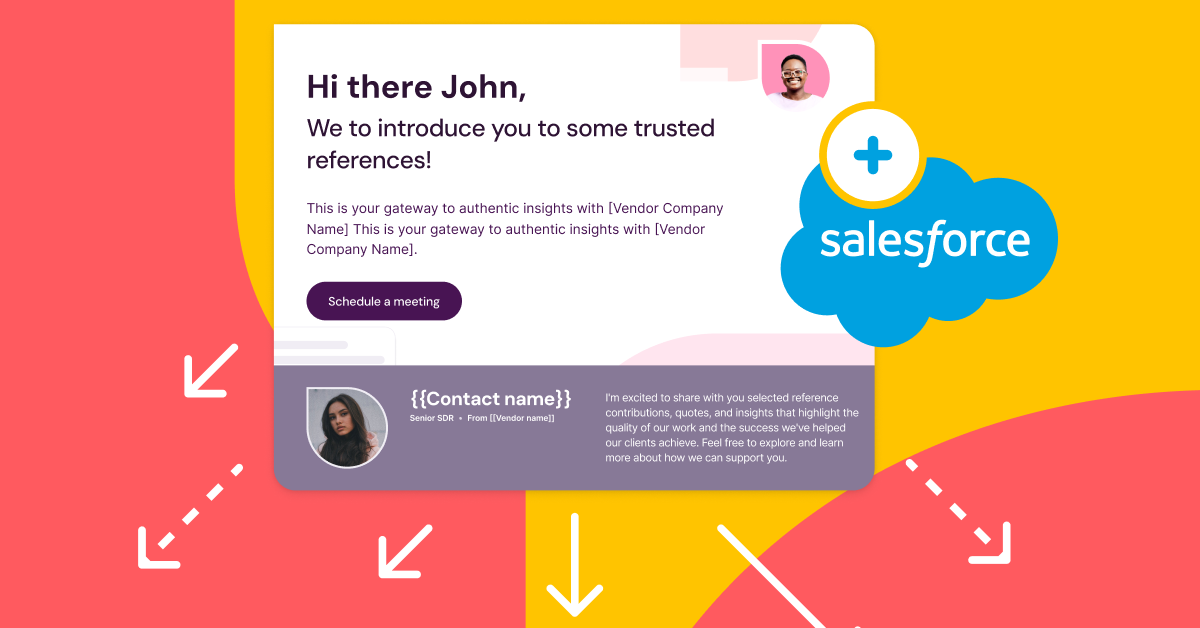
Customer feedback is incredibly versatile. One piece can be turned into multiple marketing materials, and you can even use it to address concerns or highlight benefits that are relevant to a specific segment of your target market.
Below, we'll explore four of the most effective ways to turn the feedback you've collected from the sources above into content that drives conversions.
Social is one of the easiest places to inject real customer voices.
Start simple:
Then, go beyond the usual:
This is lightweight, high-impact content that builds trust in your feed daily.
Social proof works best when it’s placed where decisions happen.
Use it strategically:
If you want to go further, use heatmaps and scroll data to place testimonials where people hesitate most. Then, A/B test quotes with different tones (e.g., emotional vs. ROI-driven) to see what converts the best.
For a more detailed look, check out my guide showing how three different companies use customer feedback to drive web conversions.
Since customers' success with your product is so closely intertwined with your USP, it only makes sense to let it drive parts of your content strategy. By incorporating real-life examples of how your product has helped customers, you differentiate your content from others, and you place your product as the solution to the problem you're solving with your content.
One idea is to use multiple feedback sources to write a trend piece: “5 Things Our Power Users All Have in Common.” To increase adoption, share that piece with all your new users (particularly those with low engagement rates) to show the value of your product.
AI makes it effortless to turn one piece of feedback into ten different assets.
With Deeto's centralized customer content repository, it's easy to organize, structure, access, and publish content across multiple marketing channels.
To know whether you're actually turning that customer feedback into sales revenue, there are six key metrics to pay attention to:
This is your most direct signal. Are pages or campaigns with testimonials, quotes, or customer stories converting better than those without?
Test it by A/B testing landing pages with and without social proof, measuring lead gen forms, CTAs, and demo requests after adding feedback-based content, and tracking product page conversions post-implementation.
Are people engaging with the content you’ve created from feedback?
Watch how repurposed reviews perform in:
Higher CTRs mean the message resonated.
Feedback-based content is supposed to feel more human and relatable. If it's succeeding in that department, it should also boost engagement.
Measure engagement with your content by looking at:
If your feedback-rich campaigns convert better, your CAC should decrease over time. Watch for changes in CAC across paid channels, email funnels, or website segments where social proof was added.
Lower CAC = higher efficiency.
Although it's " for marketing," customer feedback and other user-generated content are used throughout the sales cycle to build credibility, handle objections, and drive faster decision-making.
Deeto centralizes your content, so you can equip your SDRs and AEs with customer success stories, quote libraries, and case studies specific to each prospect's use case.
To understand how effective this is for your business, look at:
The average B2B sale requires more than 40 touchpoints. Use tools like Google Analytics, HubSpot, or your CRM to track where repurposed content shows up in the buyer journey (Deeto can help with this, too).
Did a blog post featuring a customer story bring in qualified traffic? Did someone convert after clicking an ad using a testimonial? Are your most engaged prospects reading case studies?
Look at assisted conversions, not just last-click attribution.
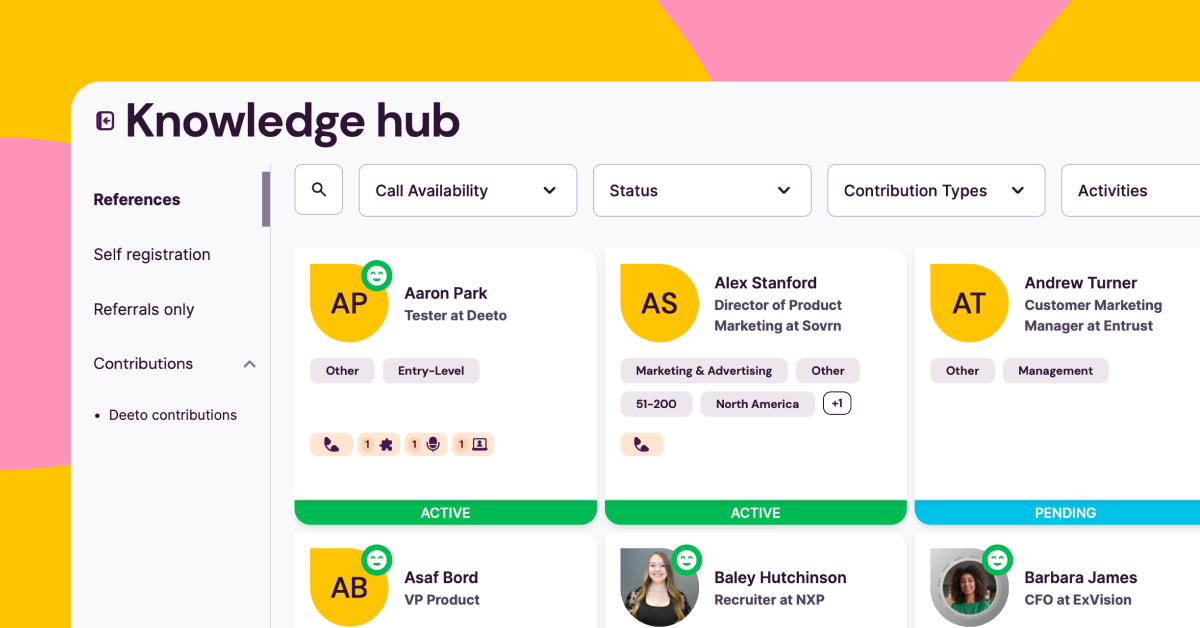
Deeto's AI-powered platform simplifies the entire process of collecting customer feedback, organizing it, turning it into content, and distributing it across your entire company — Marketing, Sales, Product, and Success.
Request a demo to see how Deeto's platform helps companies fully leverage the power of their customers' voices.

Learn how to turn customer feedback into powerful marketing content. Discover strategies for repurposing reviews and UGC
Marketing usually focuses on getting new customers through the door. But what happens after they buy?
That's the part that gets overlooked.
Yet your existing customers are your most valuable asset. They’ve already said yes. They know your product. And if you do it right, they’ll buy again, refer others, and become your loudest supporters.
Customer marketing is the way to nurture those relationships.
In today's guide, we'll break down what customer marketing is and how you can use it to grow faster, retain more customers, and turn your brand into a movement.
First, a quick definition:
Customer marketing is the practice of marketing to or with your existing customers, not just to sell more, but to build loyalty, increase retention, and turn happy customers into brand advocates.
It’s different from traditional marketing, which focuses on acquiring new leads and closing sales. Customer marketing is about deepening relationships with people who already use your product or service.
It includes things like:
It's powerful because it taps into trust. Your customers already know you deliver. That makes it easier to cross-sell, upsell, or invite them to share their experience with others.
Buying decisions are long, complicated, and full of noise. Prospects are bombarded with ads, sales pitches, and cold emails all day, every day.
But a warm referral or glowing testimonial? That cuts through.
According to data from Forrester, more than 90% of today's buyers trust their industry peers. The least trusted group? Salespeople. Less than one-third of study participants said they trusted sales reps at all.
Social proof is something you can use to drive more web conversions with your marketing content, and it's something your sales reps can use to become more credible.
On top of that, most B2Bs are retention-focused, either because they're a SaaS company with a recurring revenue model or another type of company with high-value, multi-year contracts.
Customer marketing provides a clear pathway for both customer-retaining engagement and customer-getting social proof, at scale.
Here’s the short answer: Customer marketing should be owned by marketing, but powered by everyone.
Let’s break that down.
Customer marketing is still marketing. It requires messaging, segmentation, campaigns, and content. That means it should live under the marketing team’s umbrella, with a clear owner responsible for execution.
They’re the ones best equipped to turn customer stories into case studies, build email nurture flows, launch referral programs, and manage brand experience post-sale.
Sales teams have direct lines into what prospects care about and what wins deals. That insight is gold for shaping customer marketing content.
Customer marketers can use that intel to craft high-impact campaigns that speak to future buyers using the voice of current customers.
CS is on the front lines. They know which accounts are thriving, who’s ready for a case study, and where upsell opportunities exist. They’re also the bridge to turning satisfied users into advocates, community members, and referral partners.
If they’re looped into customer marketing efforts, they can flag champions before anyone even raises their hand.
Customer marketing isn’t just about sending a few newsletters or posting a case study. It's a start, but the real focus is on how you can turn your existing customers into long-term growth drivers.
Keeping customers happy keeps revenue stable. And customer marketing reinforces the value of your product long after the sale. It helps you stay top of mind, share helpful resources, and build stronger relationships through personalization.
This is also a way to bring acquisition costs down. Retention is, on average, up to five times more cost-effective compared to acquisition.
Customers who feel connected to a brand are worth 306% more over their lifetime. And loyal customers are 5x more likely to make repeat purchases and 4x more likely to refer your brand to others.
In SaaS, the longer someone stays subscribed, the more they're worth by default.
By consistently engaging users and educating them on new features and use cases, you prevent churn, which, by extension, makes every customer worth several times more.
Customer marketing gives you a way to generate those referrals at scale. When a happy client shares their story on LinkedIn or brings you up in a Slack group, it carries real weight. No ad can compete with that.
When a customer already trusts you, it's easier to expand that relationship. Customer marketing helps your CS team highlight new offerings and additional features that align with what they’re already using.
You can’t rely on 1:1 relationships forever. Customer marketing gives you the systems to engage hundreds (or thousands) of customers with the same level of care. Whether it’s through automation, content, community, or all of the above, the right strategy lets you scale without sacrificing quality.
In general, a customer-led growth strategy yields growth, profitability, and long-term sustainability in a way other strategies cannot. Because your customer is at the center of both your marketing and your overall experience, you can innovate for them faster and differentiate yourself from the pack.
Customer-led marketing tactics are a critical aspect of this because (a) they engage your existing customers through personalization while (b) getting them more involved with your brand via advocacy and (c) making it easier to bring in and close new business.
There are several benefits to this:
Customer marketing also gives you a competitive moat. Anyone can copy features or undercut you on price. Nobody can (easily) replicate a loyal customer base that’s actively talking about how much they love your product.
If you want results, you need structure. These five pillars are the operational backbone of high-performing customer marketing strategies:
Don’t treat your entire customer base the same. Build segments based on behavior, product usage, lifecycle stage, industry, or account value. Then map specific marketing actions to each.
Use tools like your CRM, product analytics, and NPS responses to continuously refine your segments. Segmentation is useless if it doesn’t drive specific action.
Use the data you have (purchase history, usage patterns, support tickets, product interest) to deliver 1:1-feeling messages at scale.
Examples:

Personalization is timing, relevance, and context. Creating triggers based on these kinds of identifiers makes your communication feel natural, even though it's going out to thousands at once.
Customer marketing listens as much as it speaks. Build feedback loops into your strategy:
Then act on the data.
Communities build trust and stickiness. Set up forums, user groups, or a Slack/Discord channel where your customers can connect with each other and your team.
To make it work:
Notion is a great example of a company that does this better than its competitors. Their ambassador program, local meetups, online forums (Notion Communities), and content hubs increase product stickiness, generate organic UGC, and drive serious word-of-mouth.
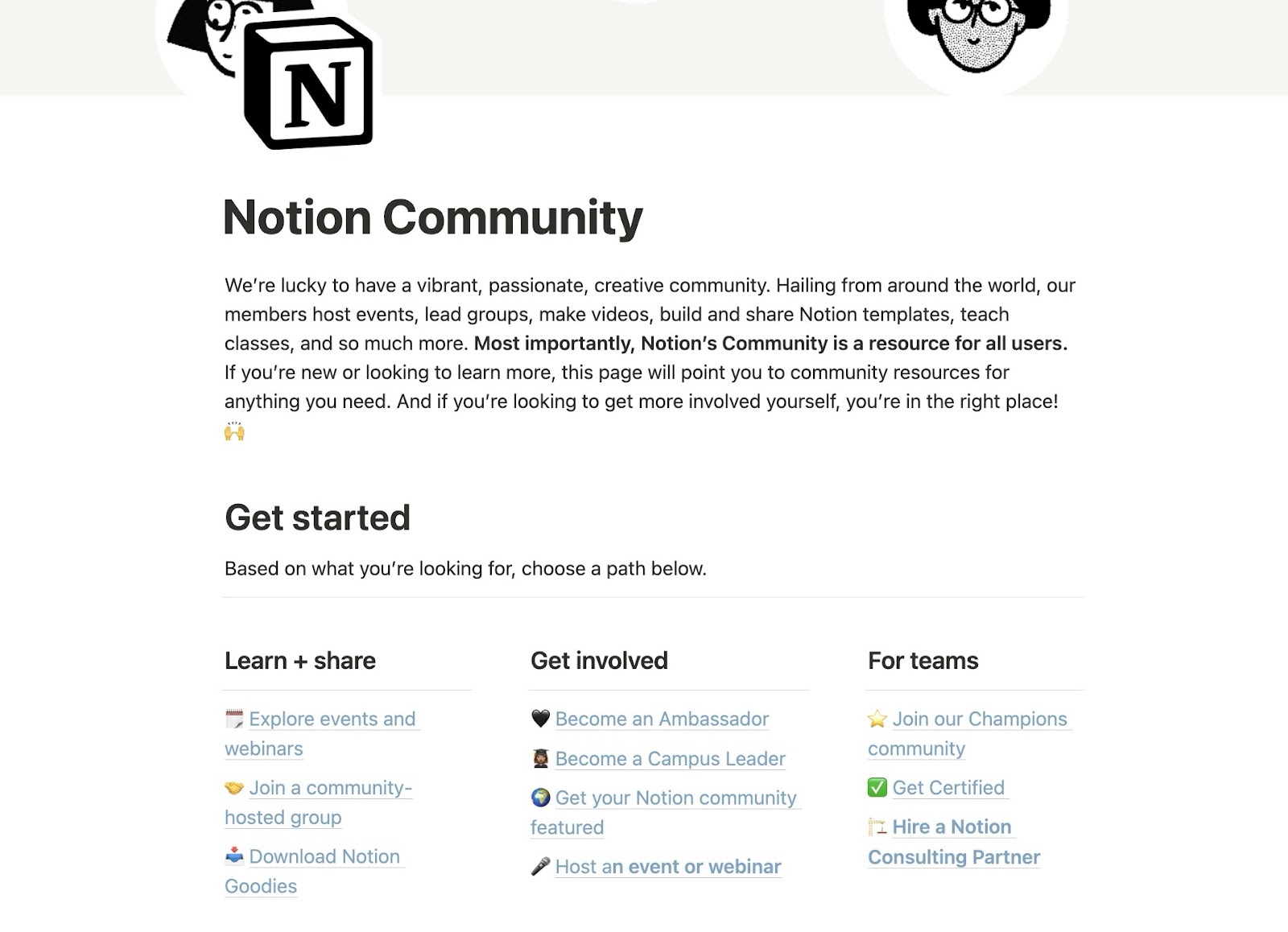
Bonus: Customers will often answer each other’s questions faster than your support team can. That’s scalable support and marketing in one.
More education = more value = less churn. Don’t assume customers know how to use everything they’ve paid for. Create a structured path to mastery.
Build content based on real usage patterns and friction points:
Tie every piece of education to business outcomes, and connect the how to the why.
Tactical execution across the right channels is how you win the customer marketing game. The best programs use a mix of personalized communication, educational content, and community to engage users and drive long-term value.
It should feel like a conversation, not a campaign. That means personalization at every level, especially when it comes to email and CRM.
Email remains one of the highest-leverage channels for customer engagement. But blasting everyone with the same newsletter won’t move the needle. Instead, build sequences around key customer moments like onboarding, product milestones, inactivity triggers, or renewal windows.
For instance, Intercom sends emails like these to make sure ever user finishes onboarding:
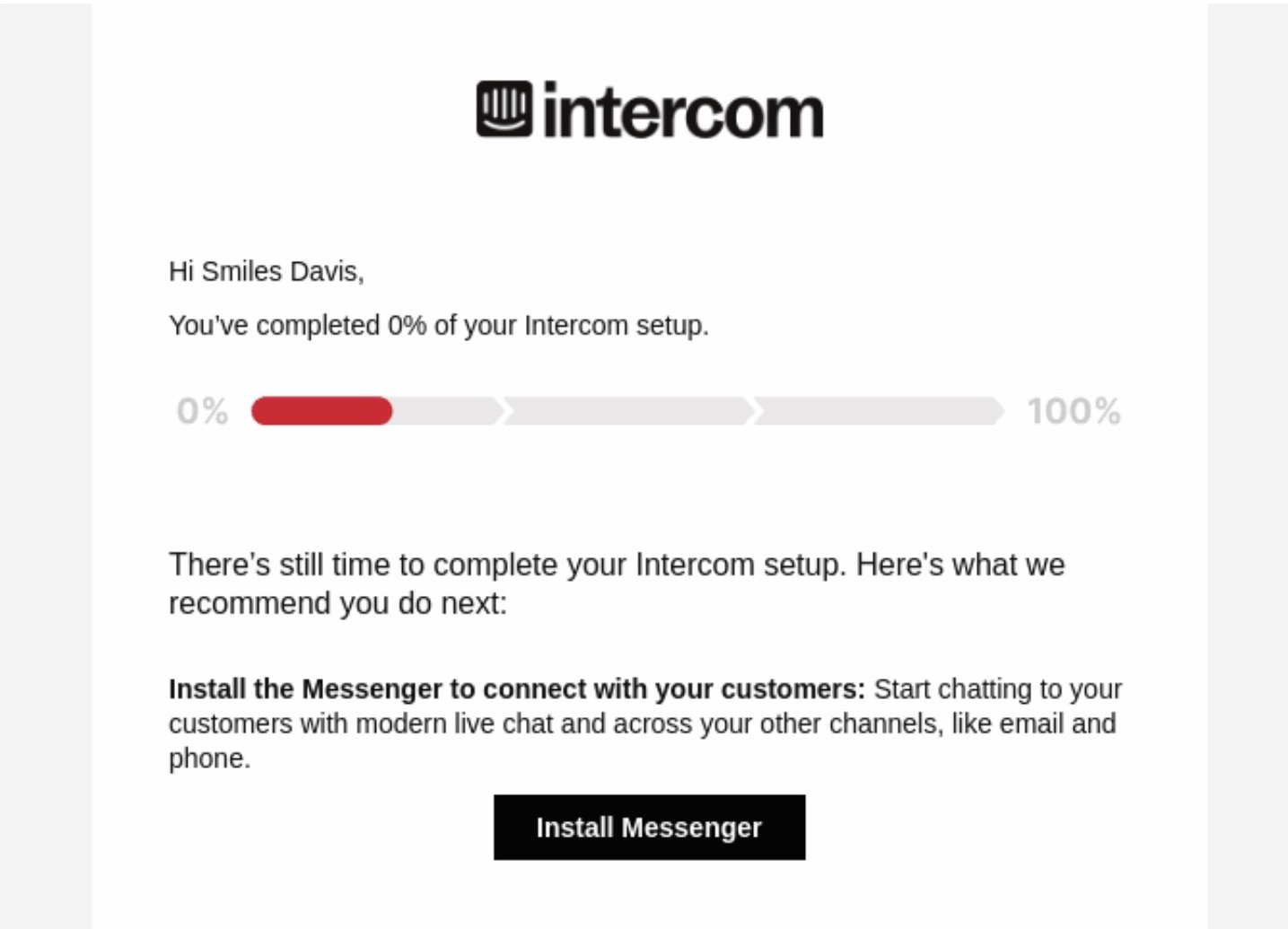
Your CRM already holds the insights you need: feature usage, support tickets, expansion readiness, satisfaction scores. Use that data to create meaningful interactions.
For example, if a customer is close to hitting their usage limit, trigger an upsell campaign before the friction. If someone gave you a 9/10 NPS score, invite them to join a referral or advocacy program right away (you can set this up with Deeto).
Most customers only use a fraction of your product. Close the gap with deep-dive guides and advanced strategies tied to real business problems.
For instance, a database/PM tool like Airtable might send vertical-specific playbooks that show exactly how to use it in marketing ops, product launches, or inventory tracking, depending on the user profile attached to the email.
Product update announcements are another big one. Every month, Slack sends out an admin update talking about new features. For big changes, they send a notification out immediately.
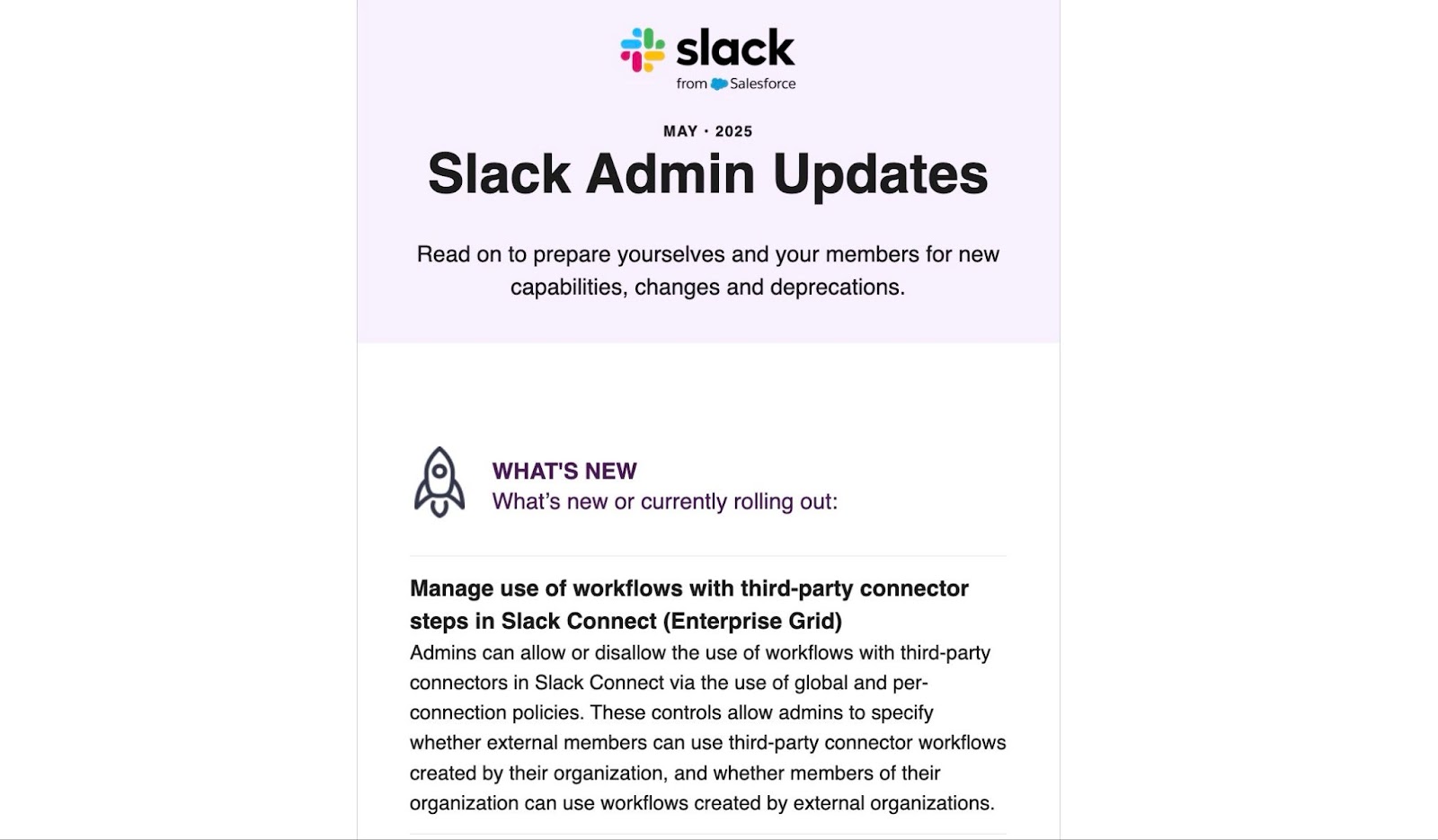
And remember that your customers often create better content than you do. UGC is one of the most effective ways to drive deal closure, so you need to make it easy for them to share how they use your product.
The more you can get people talking about your product and using it in front of others, the better.
Online communities give users a place to ask questions, get feedback, and share ideas.
Webflow’s community forum integrates docs, discussions, and a wishlist voting board to make customers feel heard and involved.
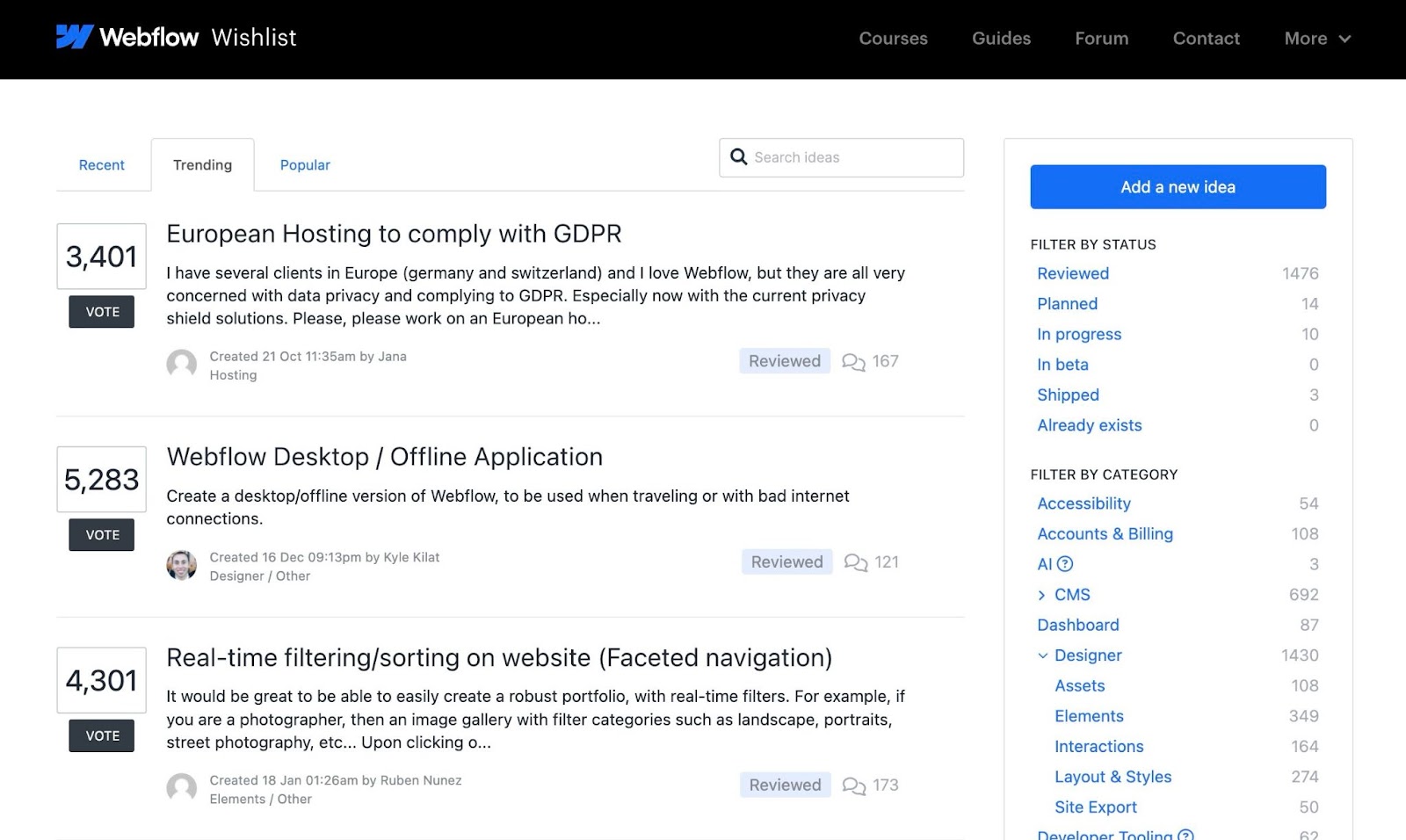
Adobe’s Creative Cloud hub mixes tutorials, peer content, and design showcases to inspire and educate.
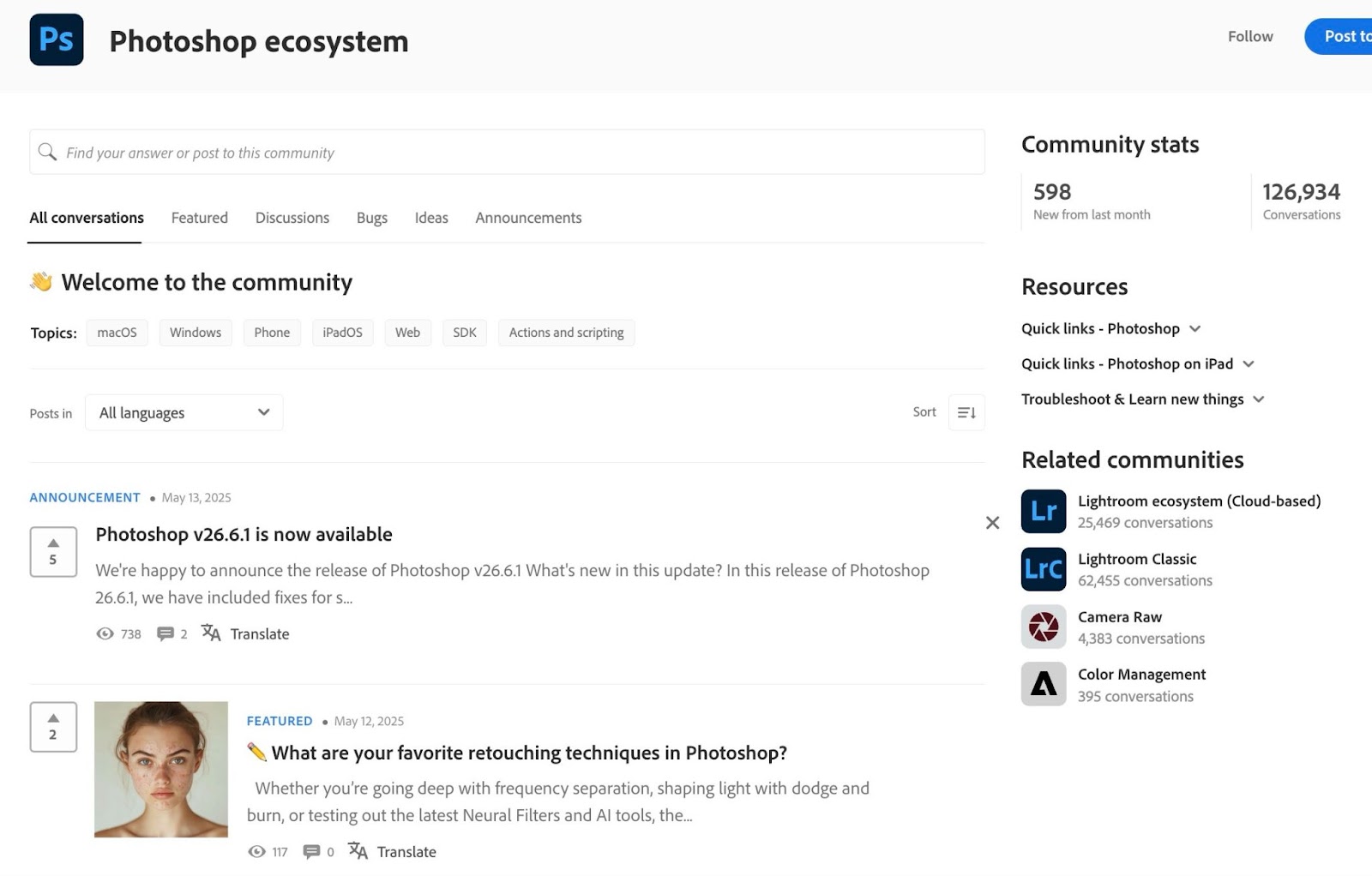
Live events are another great idea, whether in-person or virtual. They create powerful loyalty loops because you're giving your customers a stage, not just a seat.
Gong hosts customer-led roundtables where revenue leaders share real-world tactics. And Atlassian goes even further: their “ACE” (Atlassian Community Events) program lets customers run events in their own cities, with Atlassian supporting behind the scenes.
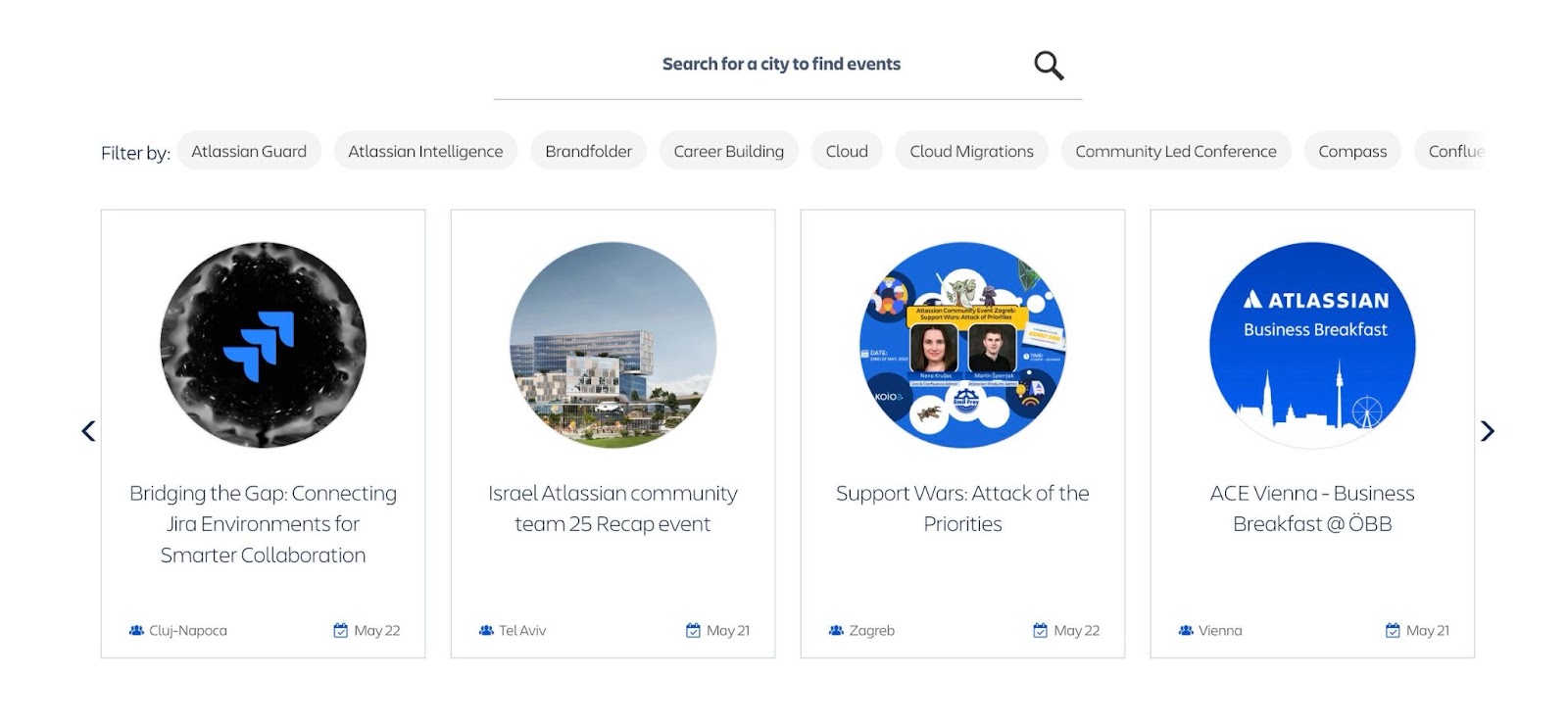
That’s community-led scale.
Maybe it goes without saying, but you can’t improve what you don’t measure. Tracking the right metrics guarantees your efforts are driving real value across retention, revenue, and advocacy.
NPS measures how likely a customer is to recommend your product to others. It's a direct indicator of satisfaction and loyalty and a strong predictor of organic growth.
A rising NPS usually means your customer marketing is resonating. A declining one signals gaps in value delivery or communication.
Retention is the backbone of customer marketing. It tells you how many customers are sticking around over a given period and how well your efforts are reinforcing product value.
Tie retention changes to marketing campaigns. Did a recent onboarding series reduce early churn or increase product adoption?
Then, break it down by segment to see where you're winning or losing.
This is the inverse of retention, and it's just as important to monitor. High churn often points to gaps in education, onboarding, or ongoing engagement.
If churn is creeping up, your customer marketing efforts aren't focused where they should be.
CLV tells you how much revenue the average customer generates over the course of their relationship with your business. Customer marketing is all about retaining users longer, increasing upsells, and keeping them engaged enough to stay and grow with you. All these things increase CLV.
Start by segmenting CLV by customer type to identify your most valuable personas. Then, use that insight to tailor content, rewards, and outreach where you see the biggest opportunities and which will have the biggest overall impact (e.g., "Basic" users upgrading to your "Pro" tier that's 2x the cost).
Your customers should be your best sales channel. These two metrics help you track how often that’s actually happening.
With a platform like Deeto, it's easy to track your referral program's performance. Who’s sending leads? What’s the conversion rate? It'll tell you everything you need to optimize your referral strategy.
You should also measure how many customers are taking advocacy actions after key milestones (e.g., feature adoption or positive NPS).
In product-led growth, your product is the main driver of acquisition, activation, and expansion. But even the best product can’t speak for itself; your customers have to.
In PLG, your most valuable growth asset is a happy, active user. Customer marketing helps identify those users and turn them into loud supporters through case studies, testimonials, reviews, social proof, and, most importantly, user-generated content.
Example: Figma’s superusers are creators inside the Figma Community and on their own respective social media profiles, They share templates and show off designs that inspire others to sign up.
PLG relies on virality: one user gets value and brings in others. But this doesn’t happen automatically.
Customer marketing accelerates word-of-mouth with:
Example: Notion turns everyday users into ambassadors by showcasing their workspace setups, templates, and productivity tips across YouTube, Reddit, and Twitter. They're even allowed to monetize their expertise by selling Notion templates on its marketplace.
Go-to-market is like any other sales strategy in the sense that advocates who've already proven your product's value are a critical driver across sales, onboarding, and expansion. In fact, with new products that haven't hit the market, even more so.
Customer marketing provides Sales with:
Example: Deeto's users use Deeto's AI-powered widgets and smart-matching algorithms to present prospects and sales reps with the most relevant references and social proof content at any point in the sales cycle.
Of all the things you can't miss, technology has to be the most critical. Manually managing these things will all but guarantee you stay disorganized and fail to execute consistently across hundreds (or thousands) of users.
These are your backbone. They hold all your customer data and communication workflows. You'll use them to centralize customer profiles and activity, trigger personalized campaigns based on behavior, and align Customer Success, Marketing, and Sales around a single source of truth.
Tools worth checking out: HubSpot, Salesforce, Customer.io
These are the platforms you'll need in order to track NPS, CSAT, and feature adoption. They're also how you'll identify promoters and churn risks and collect insights that shape campaigns and content.
Tools worth checking out: Pendo, Hotjar, Delighted, Mixpanel
You need consistent, personalized communication to stay top of mind and drive value post-sale. An email software will automate the process of sending lifecycle emails, feature tips, and upsell offers. You can create journeys based on user behavior, and even blend email, in-app messaging, and SMS if you need to (with the right platform).
Tools worth checking out: Klaviyo, Iterable, Customer.io
Advocacy is where customer marketing compounds. These tools help you turn satisfied users into active promoters.
Deeto is unique in this category because it helps you scale word-of-mouth by turning customers into on-demand advocates. You can invite users to share feedback, join reference programs, refer new leads, and take part in case studies, all from one dashboard.
That same platform presents segment-specific content to your marketing and CS teams and prospect-specific references to your sales team. And generative AI allows you to repurpose and share content across your entire ecosystem almost instantly.
Want to see it in action? Request a demo and we'll show you how it works.

Learn what customer marketing is, why it matters, and how to build strategies that drive retention, loyalty, and growth.
B2B sales are naturally more drawn-out than their B2C counterparts. There are more stakeholders, higher price tags, and more risk involved. That’s just part of the game.
But there’s a difference between “long” and too long.
Buyers don’t just dislike friction, they actively avoid it. And nothing kills momentum faster than a drawn-out sales process full of follow-ups, delays, and unclear next steps.
In today's article, I'll walk you through 10 strategies you can use to get deals across the finish line faster.

The faster you can educate your buyer, align with their needs, and get to a decision, the more likely you are to win the deal. According to Ebsta's 2023 B2B Sales Benchmark Report, deals that close within 31–60 days have significantly higher win rates. And when a deal remains open beyond twice the average sales cycle length, the chance of closing drops to just 3%.
A shorter sales cycle has ripple effects across your entire business. It leads to:
You can fit more deals into the pipeline at once, with better margins and more predictable cash flow, while making it more seamless for buyers to actually give you their money.
The problem is that sales cycles are getting more complicated. Capchase's 2023 report indicates that B2B SaaS sales cycles have lengthened by an average of 3.8 weeks across companies, which leads to increased customer acquisition costs and reduced revenue per unit.

Before you can speed up your sales cycle, you need to understand where it actually begins, how it progresses, and where it tends to stall.
In B2B sales, you have multiple conversion points.
Each of those transitions is a handoff, and each handoff is a potential slowdown.
Start by documenting the full journey from first touch to closed deal. Break it into clear stages—lead capture, qualification, demo, proposal, negotiation, close—and identify the key actions or signals that move a prospect forward.
Once you’ve outlined each stage of your sales cycle, dig into the data and measure how long leads typically spend in each one. You’re looking for averages, outliers, and patterns.
With answers to these questions, you can zoom in on the slowest stages and fix what’s broken — e.g., a content gap, poor qualification, or an unclear next step.
Now, you have a benchmark. So you can ask yourself why certain stages take longer than they should. This is where the real optimization work begins.
Look at:
Talk to your sales team. Listen to recorded calls. Review proposal feedback.
Once you've figured out exactly where in the sales cycle you're taking too much time, you can start applying targeted fixes that actually move the needle. Below are 10 strategies you can use to do so.
If you're facing problems further down the funnel with leads who were never going to close, eliminating them at the source (the top of the funnel) will save you time and give you resources back in every stage thereafter. That's why bringing the right leads in is one of the most impactful improvements you can make: it gives back wasted time to every subsequent stage.
Your ideal customer profile (ICP) should define the company size, industry, pain points, and buying triggers that make someone a strong fit for your solution. If a lead doesn’t check enough of those boxes, they’re not worth the time investment.
Don’t leave qualification to gut instinct. Your sales playbook should use proven frameworks like:
The right methodology depends on how complicated your buying process is, and how many people are involved in the average buying group. Enterprise deals do better with a more involved framework like MEDDIC, for example.

A weak discovery call leads to vague proposals, unclear value, and deals that stall. If you want to shorten your sales cycle, you need to nail discovery because that’s where momentum begins.
Don’t stop at surface-level pain points. Go deeper.
Instead of asking“What’s your biggest challenge?” ask:
Your sales reps' goal isn’t just to collect information. It’s to create urgency, build trust, and show the buyer you understand their world better than your competitors do (your chosen methodology will guide this).
Buyers don't care about fancy features. They care about what those features can do for their businesses. Maybe they want to reduce churn by 15%, enter a new market, or eliminate some of their manual workloads. When you connect your solution directly to those business-level goals, you make a more compelling case for your product, which drives faster decision-making.
77% of B2B buyers are more likely to engage with sellers who show they understand their needs through personalization. And personalization is shockingly uncommon. Check your email inbox, look at all the pitches you get, and you'll see what I mean.
The best way to differentiate is through solution selling. The problems your reps uncovered in the qualification stage? Those are the things all the future conversations, demos, and enablement content should be centered around.
Deeto helps you personalize even further, even easier. Our smart-matching algorithm automatically shows your reps relevant references, use cases, and social proof collateral with each prospect, based on identifiers like their industry and company size.
It also helps to spend 5–10 minutes researching the company and the contact before each interaction. Look at recent press, LinkedIn activity, tech stack, and hiring trends. Then use that intel to ask smarter questions and position your solution more strategically. At the very least, it'll show them you've done your homework.
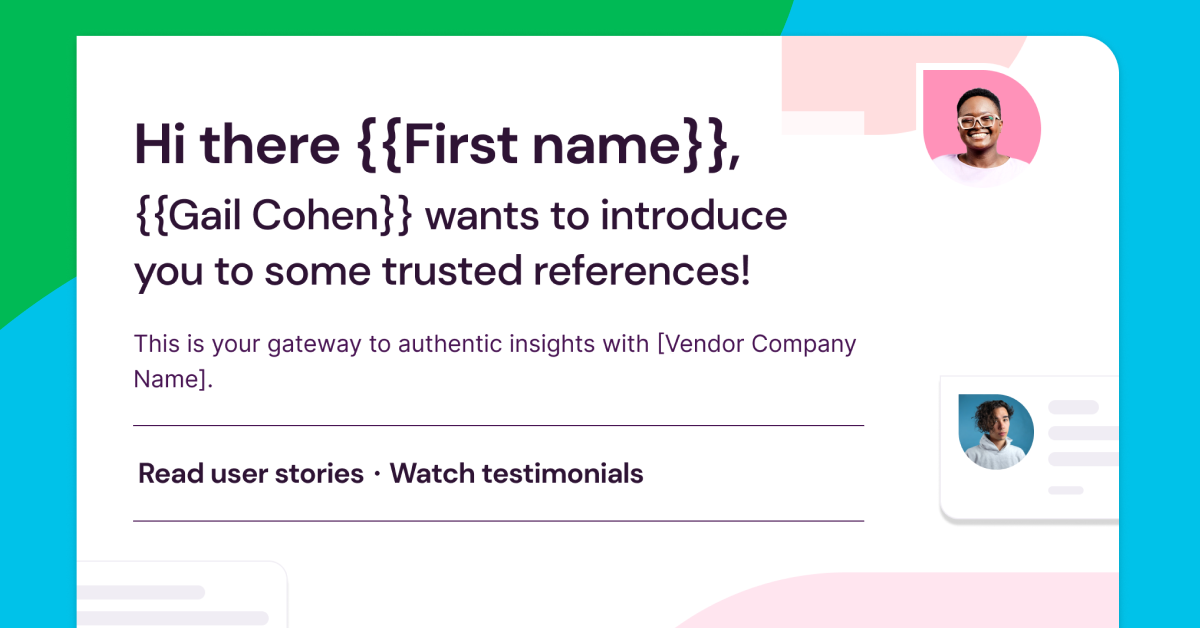
AI and automation tools can actually make you MORE authentic — that is, if you use them properly. A few critical ones:
Deeto plugs into your existing sales automation stack to amplify its time-saving benefits. By integrating with your CRM and sequencing tools, it streamlines social proof and reference sharing by automatically surfacing real customer stories that match your prospect’s profile.
There are plenty of ways to drive conversions using social proof (it influences 90% of buyers comparing products). The key is to use the right types of social proof. If your marketing attracts the wrong leads, you'll waste too much time qualifying people who were never going to buy.
That means featuring:
If a SaaS CFO lands on your site and sees a testimonial from another SaaS CFO explaining how they eliminated 90% of their financial reporting inaccuracies, you’ve got instant relevance.
Deeto's AI-powered widget makes it easy to distribute social proof across your website, and there are plenty of other places to incorporate this content into your sales cycle:
When buyers hesitate, it usually isn’t because they actually need more time. It’s because something feels unclear, risky, or misaligned.
You already know what objections come up most often:
Bring these up before your buyer does. Frame them in the context of other customers who felt the same way, and explain how they moved forward anyway.
To make this the standard across your sales org, create a centralized objection-handling library your reps can pull from. And make it a part of your ongoing training to practice handling these objections in mock sales calls.
Influ2 data shows that more than half (53%) of teams have issues with hand-off misalignment between sales and marketing. But you also have approvals from legal and finance (and, for enterprise deals, possibly your product team) to worry about.
There are a few steps you can take to eliminate those issues:
If your proposals are confusing, overly technical, or missing key details, you’ll create hesitation, even if everything you've done up to this point has been executed perfectly.
Your proposal should feel like a no-brainer to the buyer.
That means:
Use templates, but tailor them. And deliver them fast, ideally within 24 hours.
Bonus tip: Include a short video walkthrough of the proposal to give context and increase engagement.
This is a huge drag point, especially in enterprise sales. But you can speed it up by using standard contracts that legal has already pre-approved and building optionality into pricing and terms to reduce back-and-forth.
You can also offer redline templates to guide negotiations through your contracting and e-signature tool, which further reduces the overall friction here.
Dig into your CRM and analytics platforms to uncover:
Deeto surfaces valuable insights into engagement with reference content, buyer-to-buyer storytelling, and customer quotes, which tell you which proof points drive the most velocity and which customer stories resonate with which segments. That gives you a data-backed understanding of how trust accelerates deals.

Nothing brings buyers to a "Yes" faster than hearing from someone who’s already been in their shoes and came out the other side with results. That’s the power of advocacy. It’s word-of-mouth marketing that’s both free and incredibly persuasive.
When you're building your customer advocacy program, don't leave out any of the following steps:
Deeto pulls all of your advocacy efforts into one place and simplifies them, so you’re not looking through thousands of content pieces, scrambling for references, or spending months to create one case study.
Request a demo to see how it works.

Discover 10 proven strategies to shorten your sales cycle, close deals faster, and boost revenue. Learn how Deeto helps!
Your content shouldn’t be stuck in silos—it should be working for you. That’s why we’re excited to introduce Imported Contributions, a new feature that allows you to seamlessly bring external content into Deeto and share it effortlessly using our website widget, microsites, and more.
With Imported Contributions, you can import testimonials, case studies, customer reviews, and other valuable materials—regardless of where they were originally created. Once inside Deeto, your content is instantly organized and ready to be shared across:
No more scattered assets. No more wasted content. Just a central hub where everything is easily accessible and shareable.
Get up and running in minutes—import content and start sharing instantly.
Your repository is never empty. Every imported asset becomes a source of multiple shareable pieces.
Repurposing content manually takes time. Let AI do the heavy lifting by pulling out key insights and turning them into ready-to-use assets.
Make sure your best content is working for you. Seamlessly share it across G2, microsites, and personalized reference experiences.
This feature is perfect for teams looking to maximize their existing content:
Bringing content into Deeto is just the beginning. Our AI Agent goes a step further by automatically analyzing your imported materials and extracting key insights. This means:
Setting up your Deeto repository is quick and simple:
What is this feature, and why was it developed? Imported Contributions turns Deeto into a single source of truth for content collection, management, and distribution. It simplifies onboarding and drastically reduces the time to value.
Imported Contributions is now live. Log into Deeto, start importing your content, and transform your assets into powerful, shareable materials.
If you have any questions, we’re here to help.

Bring All Your Content into One Place

See how Deeto helps you turn customer voice into a GTM advantage.
© 2025 Deeto. All rights reserved.